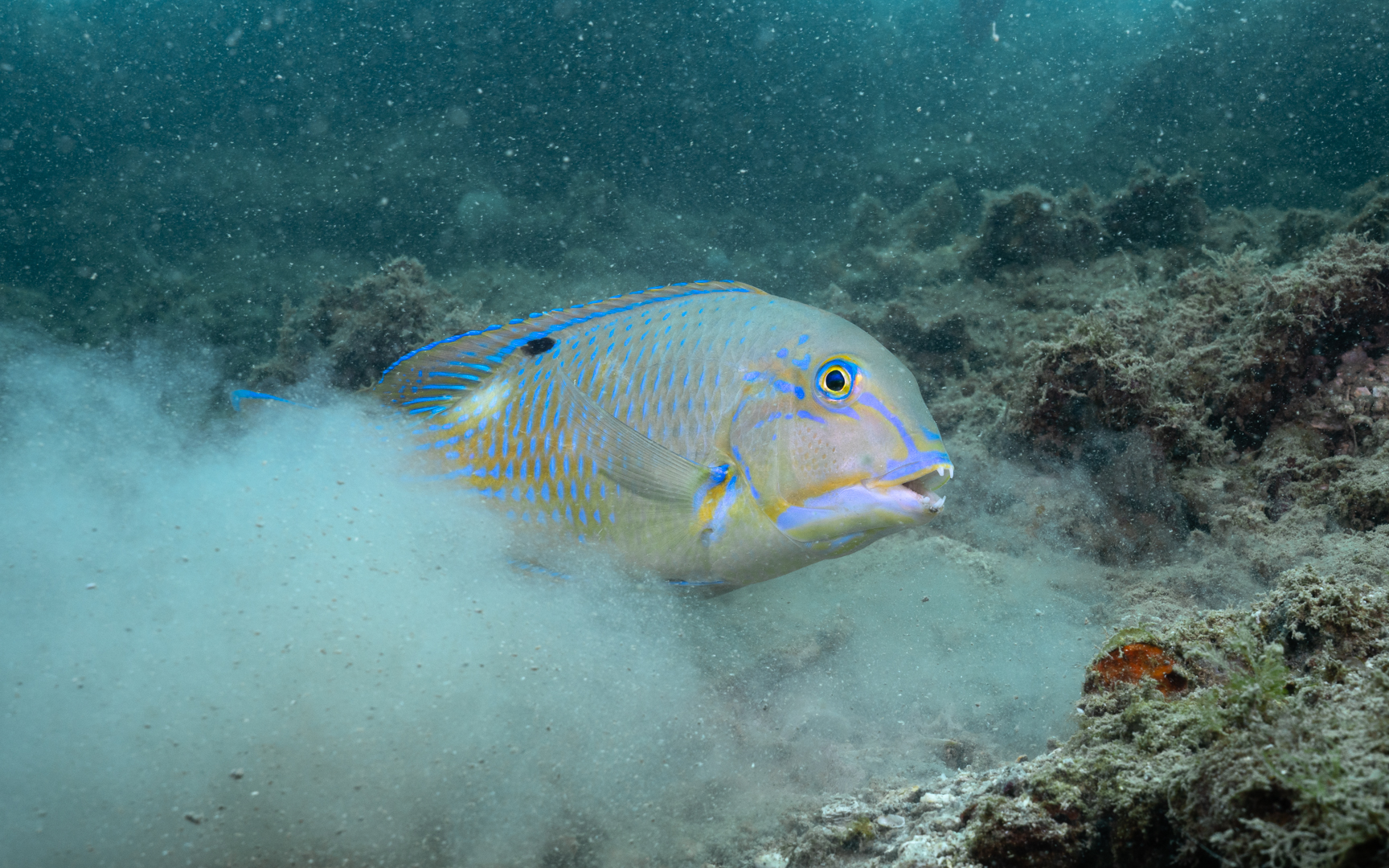Scientific Name: Choerodon schoenleinii English Name: Blackspot tuskfishObserved in: Pulau Hantu, SingaporeObserved Water Depth: Around 10mObserved Timing: Jun-23 標準ズームをテストしていたその日、目の前で地面をほじくり返しだした大きな個体。私たちのことなど意に介す様子もなく、豪快に土煙を挙げていく。シロクラベラ、日本でも観察できるようで、沖縄では高級魚として重宝されるらしい。美味そうには見えないけれど。。 標準ズームのテスト結果は、雑記にまとめました。https://www.fishbone.site/notas/5420/
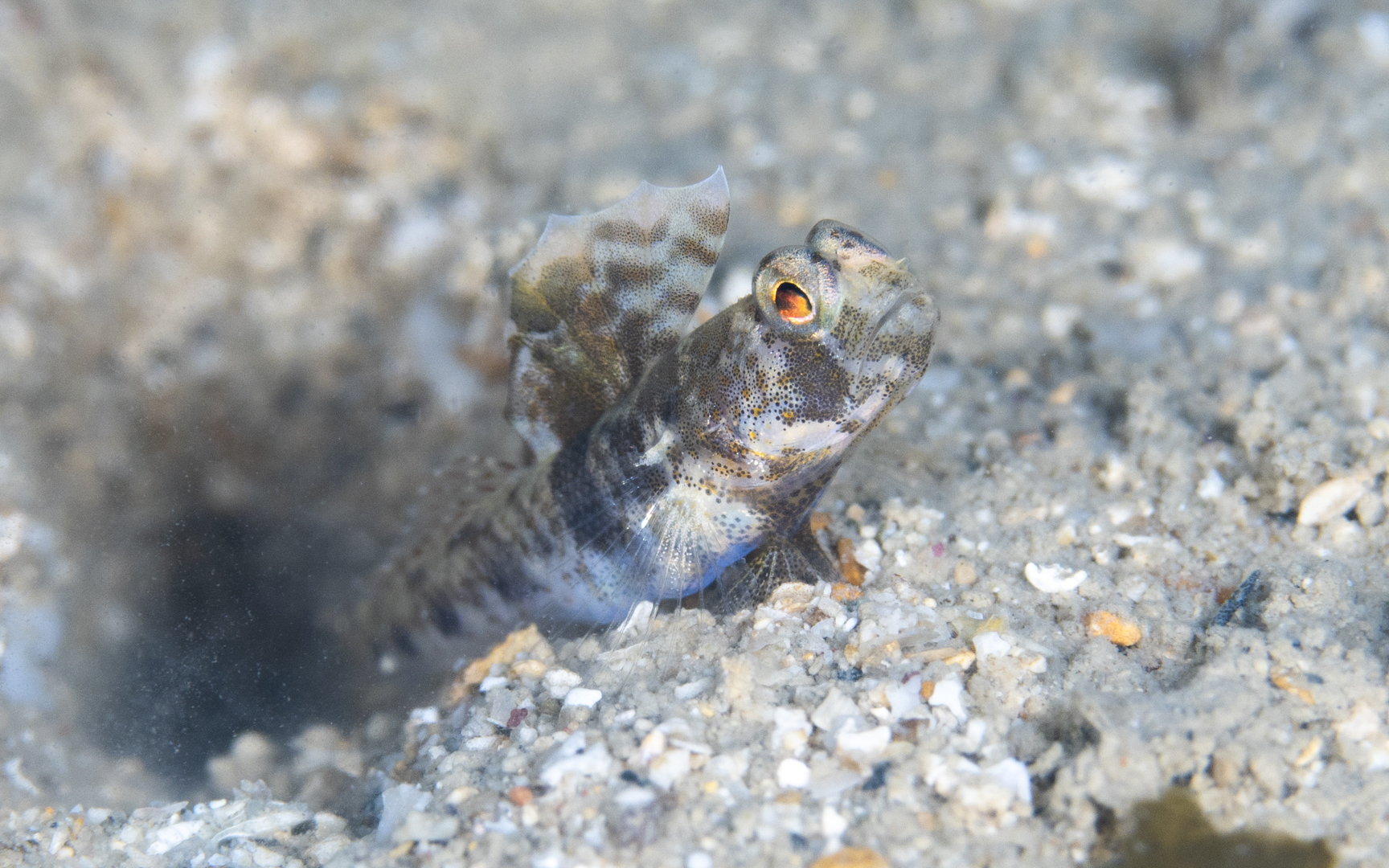
Tomiyamichthys russus – ウシオニハゼ
Scientific Name: Tomiyamichthys russusEnglish Name: Ocellated shrimpgobyObserved in: Pulau Hantu, SingaporeObserved Water Depth: Around 15mObserved Timing: Jan-23 シンガポールダイバーが毎週集まるPulau Hantu。その北側、Bukom島との間の水路には、砂丘のような水底をした環境があります。そこはシンガポールでもっともハゼの観察に適した場所であり、他の場所にはいない種が数多く生息しています。この時もまた初めて出会いがありました。おそらくウシオニハゼの幼魚であると思われ、非常に立派な背鰭を開閉させています。オニハゼ属を当地で確認したのは初めてとなりました。
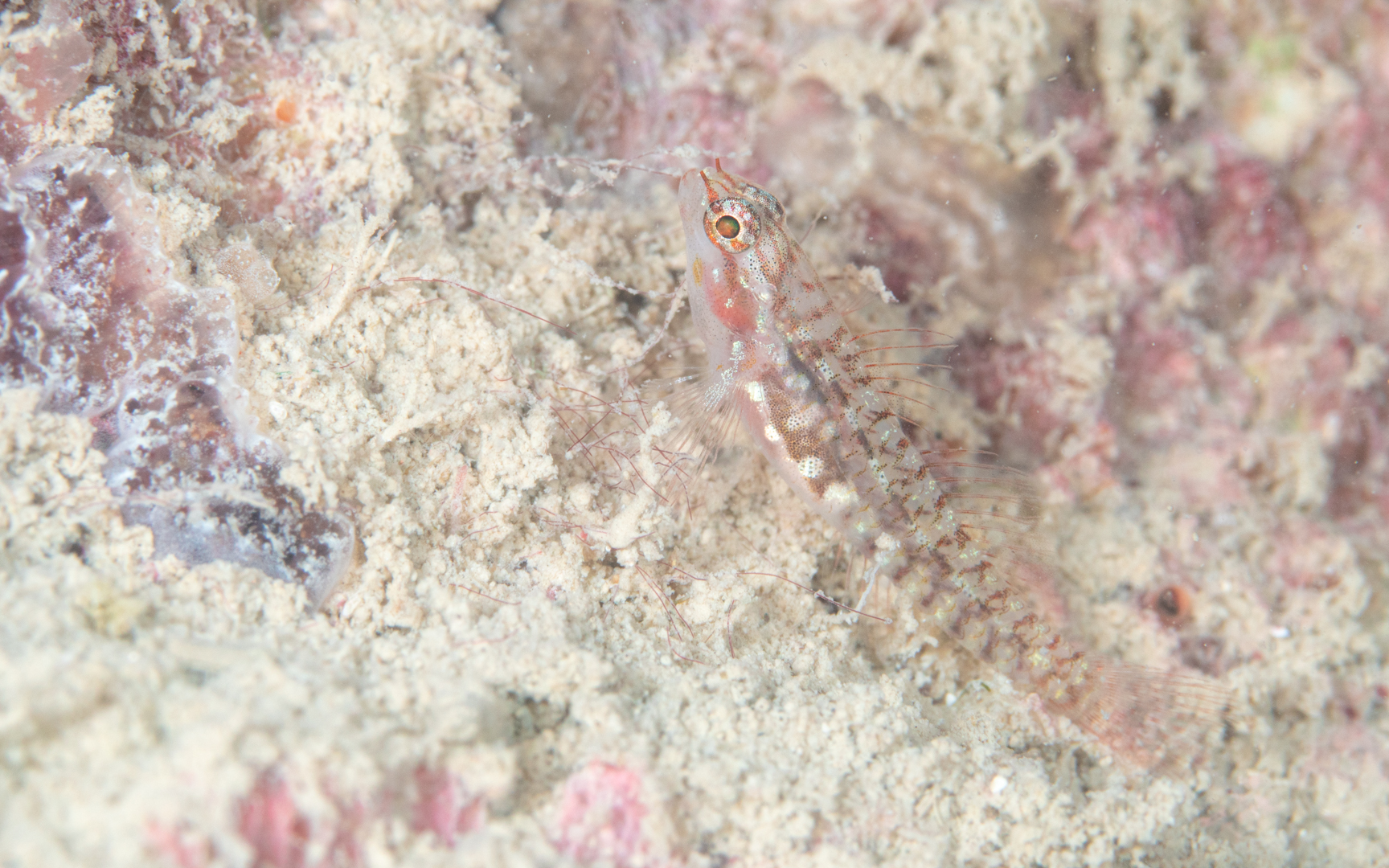
Eviota storthynx – キンホシイソハゼ
Scientific Name: Eviota storthynxEnglish Name: Storthynx dwarfgobyObserved in: Pulau Hantu & Sentosa, SingaporeObserved Water Depth: Around 4-10mObserved Timing: Nov-21, Mar-22 傾注しているハゼ科の魚類の中でも、特にイソハゼ属の仲間は観察しがいのある対象です。英語でいえばDwarf gobyであり、その名の通り小さい。水底やサンゴなどあらゆる場所で見かけられ、種数も多いが、通常種の中に紛れる希少種を探すのはさながら宝探しのようです。また、間合いの駆け引きはシビアとなります。気配を察知されれば次の瞬間には岩陰の奥底に逃げ込むし、共生ハゼなどと異なり、どこにだって移動できるからです。 そんなイソハゼですが、当地での観察機会は非常に限られています。水底は基本的に砂~シルト泥で死サンゴや小石が転がっている場所があまりないことと、サンゴや岩石は堆積物に覆われておりおそらくイソハゼにとってよい環境ではないのかと思います。 諦め悪く探し続け、漸くこのキンホシイソハゼに出会えた時には、追い求めてきた獲物(?)の登場に、文字通りアワアワしてしまいました。 Eviota – Drawf goby is a genus one of the most attractive. It’s due to a variety of species and also a difficulty of photographing. Normally Eviota is everywhere, however herein Singapore, it’s uncommon. I guess heavy sediment on coral is one of that reason. This storthynx dwarfgoby is finally observed with my 10th diving in Hantu. That was great encounter indeed, because I come to know they are living here!! Honestly, I was almost giving up them.
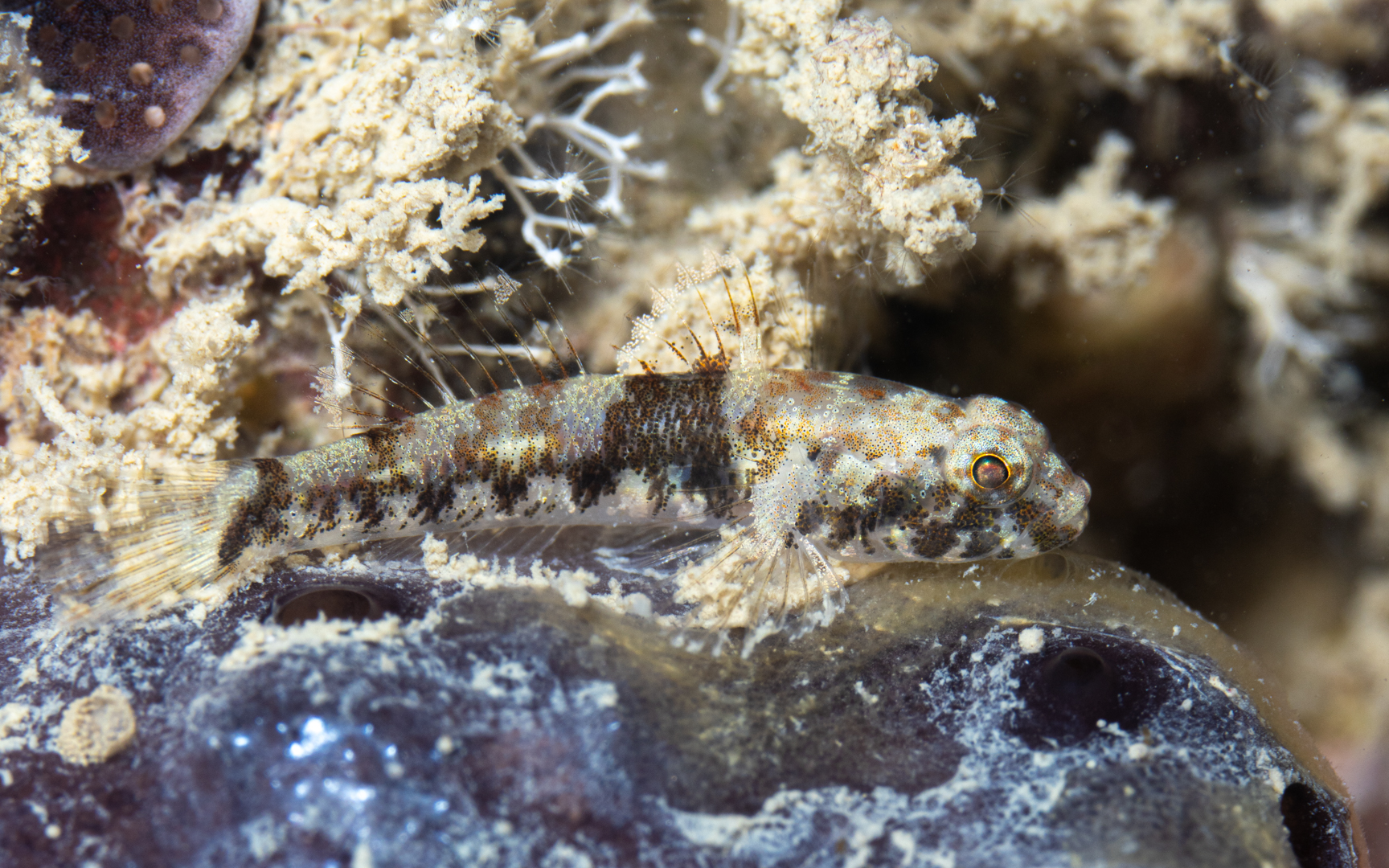
Bathygobius hongkongensis – クロホシハヤズハゼ
Scientific Name: Bathygobius hongkongensisEnglish Name: –Observed in: Pulau Hantu & Sentosa, SingaporeObserved Water Depth: 3 -10 mObserved timing: Nov-21, Mar-22, Apr-22 日本ではクモハゼ属のいづれも見たことはなかったが、当地では2種に出会うことができている。本種はクロホシハヤズハゼ。なんだか名前がかっこいい。 初回の発見は、淡いエメラルドグリーンに輝くサンゴ上でした。綺麗な背景に初見のハゼ。慌てて設定を直しながら撮影に入りました。しかし興奮相まり体制がなかなか整いません。。そうこうしている内に堆積物の吹き溜まりに追い込んでしまいましたが、なんとかピンが得られた、、 鮮やかなオレンジが印象的な写真は、別日に全く別の場所で撮影したもの。サンゴの下に何かいないかと寄ってみると、隠れていました。最短距離まで寄ってもびくともしないのは、いまさら動いたらバレるし、相手(=私)が気づいていない可能性に賭けたのでしょう。魚と対峙していると、ときどきそういう瞬間あります。 その後、岩の陰に空いた小さな穴の中で何か動いていると思ったら、当種の幼魚だったりと、何度か見つけることができている。カメラをほとんど最短撮影距離まで近づけていっているのにも関わらず、穴から徐々に出てくる無防備っぷり。幼魚のほうが、好奇心旺盛なのかしら。 I’ve never observed Bathygobius genus in Japan for some reason, while here in Singapore, already two are spotted in night dive in Pulau Hantu. 1st dorsal fin edge is colored white and it makes this species more special. When I spot it first time, it seated on that bright green coral. That was actually perfect situation for shooting with such the beautiful background. However, this special situation make me be over excited, and I got him away at the corner as you see in 3rd…
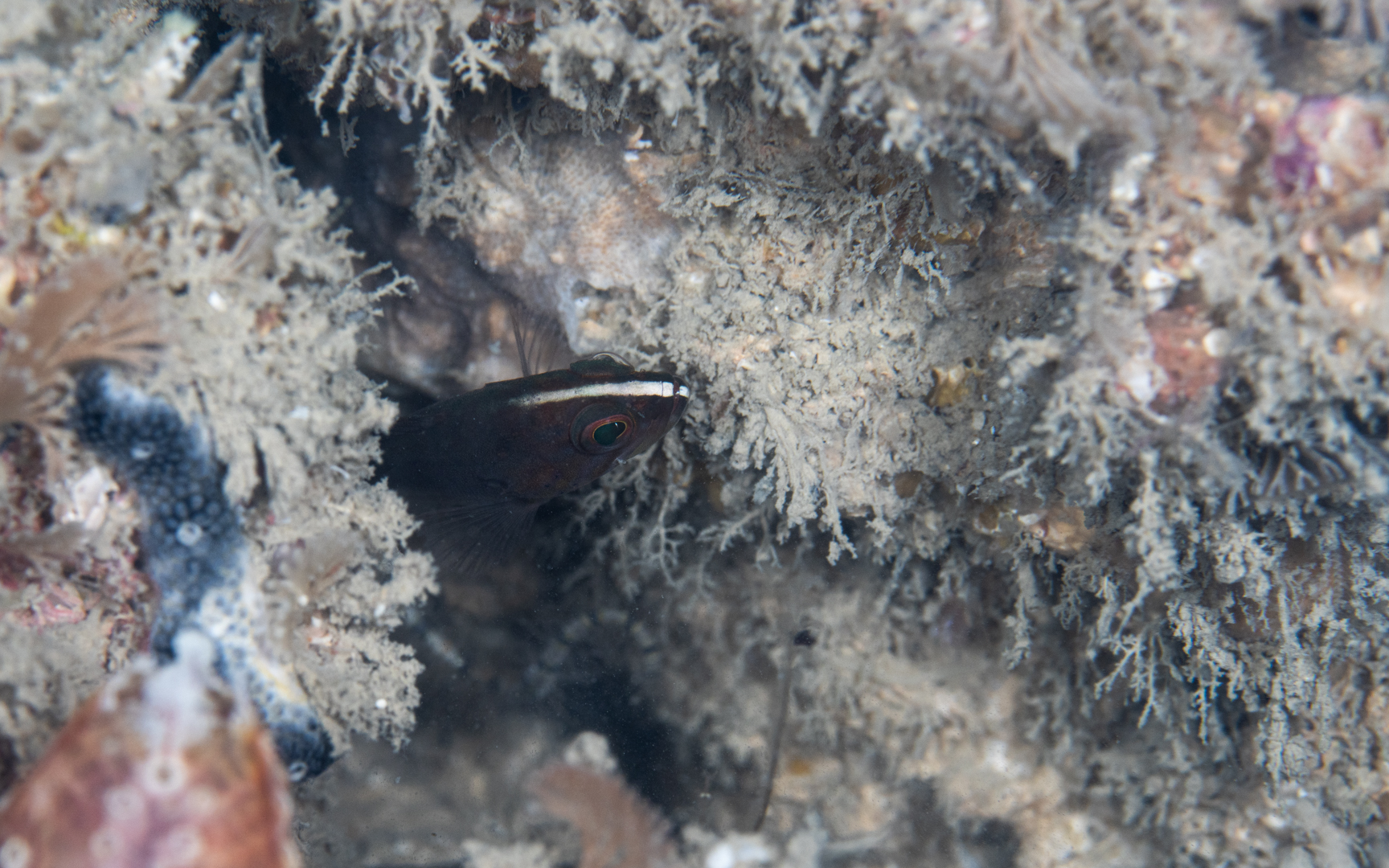
Cephalopholis boenak – ヤミハタ
Scientific Name: Cephalopholis boenakEnglish Name: Chocolate hindObserved in: Pulau Hantu, SingaporeObserved Water Depth: Around 10-15mObserved Timing: May-23 白い通った鼻筋が特徴的です。図鑑を検索するも検討がつかず、ChatGPTに幼魚のころには額を通る白い線があるハタ科の魚類のリストを挙げさせてみるも、見当違いの回答ばかり。。あきらめかけていたところ、鈴木さんの魚図鑑があることを思い出し、ぱらぱらとめくってみると見事にヒットした。素晴らしい図鑑です。 The distinctive feature is the white line that runs through the nose. Despite searching through field guides, I couldn’t come to a conclusion. I tried asking ChatGPT for a list of fish species in the grouper family that have a white line running across their foreheads when they are young, but the answers were way off. Just as I was about to give up, I remembered Suzuki’s fish field guide, and when I flipped through it, I found a perfect match. It’s an excellent guidebook.
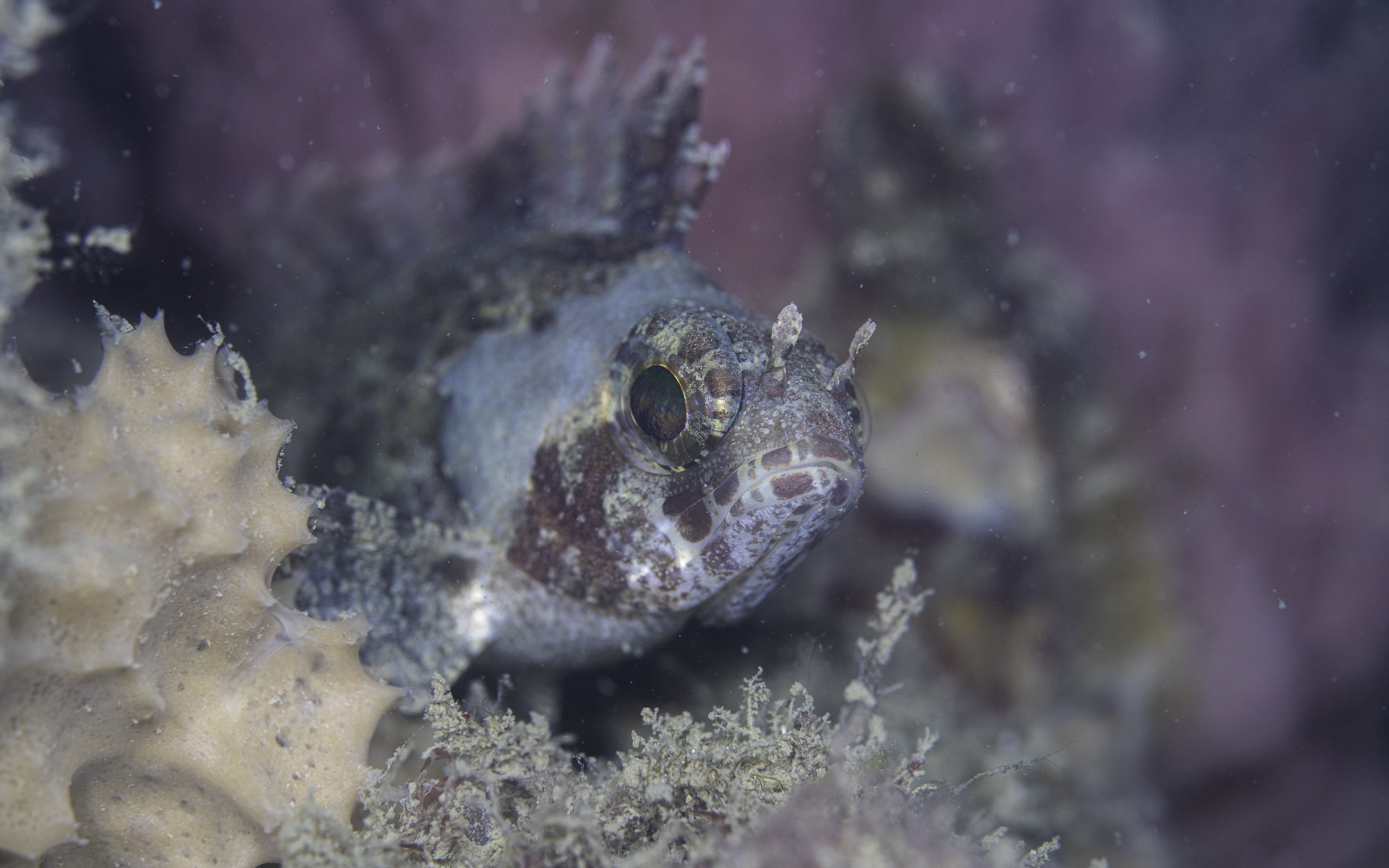
Centrogenys vaigiensis – オニハタ
Scientific Name: Centrogenys vaigiensisEnglish Name: False scorpionfishObserved in: Pulau Hantu, SingaporeObserved Water Depth: Around 10-15mObserved Timing: Dec-21, Mar-22, Oct-22 オニというにはかわいい顔つきであるし、ハタというのにハタ科ではない。フサカサゴに擬態している、オニハタ科の種だ。英名を直訳すればニセカサゴなので、そっちの名前のほうがしっくりくる。そういえば、シンガポールの海でカサゴを全く見ていないな。どこかにはいるのだろうけれど。。 Though it is called Oni-Hata in Japanese, Demon Grouper, it has an adorable appearance and it’s not a grouper in the true sense. It belongs to the Centrogenyidae family indeed. It mimics the appearance of a scorpion fish. In this regard English name is much better than Japanese one to explain the guy. Come to think of it, I haven’t seen any scorpionfish in Singapore’s sea. They must be somewhere, though..
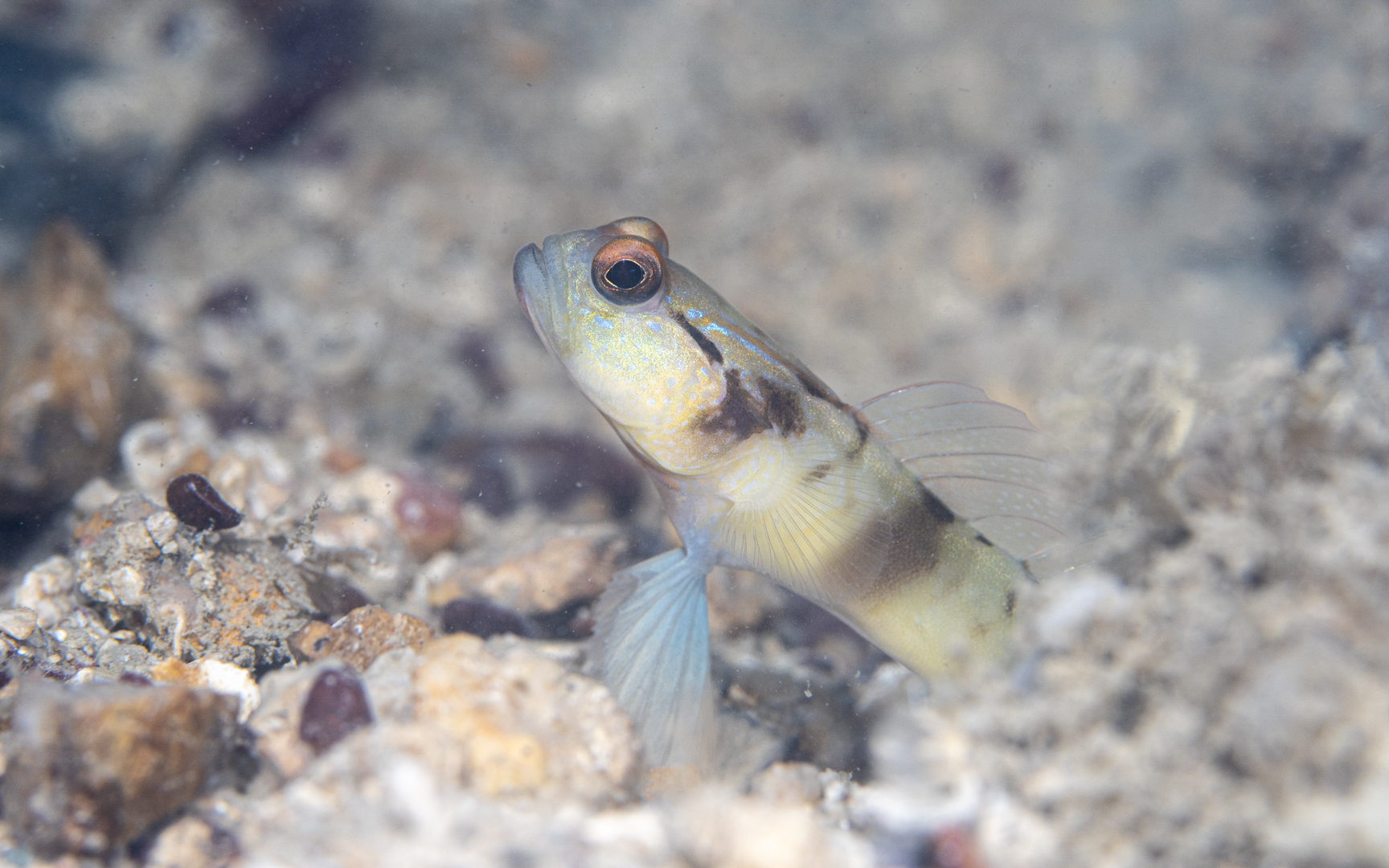
Amblyeleotris gymnocephala – マスクドシュリンプゴビー
Scientific Name: Amblyeleotris gymnocephalaEnglish Name: Masked shrimpgobyObserved in: Pulau Hantu, SingaporeObserved Water Depth: Around 10-15mObserved Timing: Nov-21, Jun-23 目の横から延びる黒い線が特徴のダテハゼ。シンガポールの海に潜り始めてから間もないころに見ることができたが、その一回きり、今まで機会がない。場所はなんとなく把握しており、同じ場所にイマキュレートゴビーなどもいるはずなので、じっくり潜ってみたい。 追記)1年以上の期間を経て久しぶりに見つけることができた。その間インドネシアなどでも当種を見つけたが、当地に生息するものは、それと比べて目から延びる線が随分と細く、しかしくっきりとしている。観察場所はHantuの北側であり、前回の西側ではなかった。 This Amblyeleotris is characterized by a black line extending from the side of its eyes. I was able to see it shortly after I started diving in Singapore, but it was only that one time. I have a rough idea of the location, and I expect to find other species like the Immaculate Goby in the same area, so I want to dive there and explore thoroughly. Update) After more than a year, I finally managed to find it again. In a meantime, I also spotted the same species such as in Indonesia, but the…
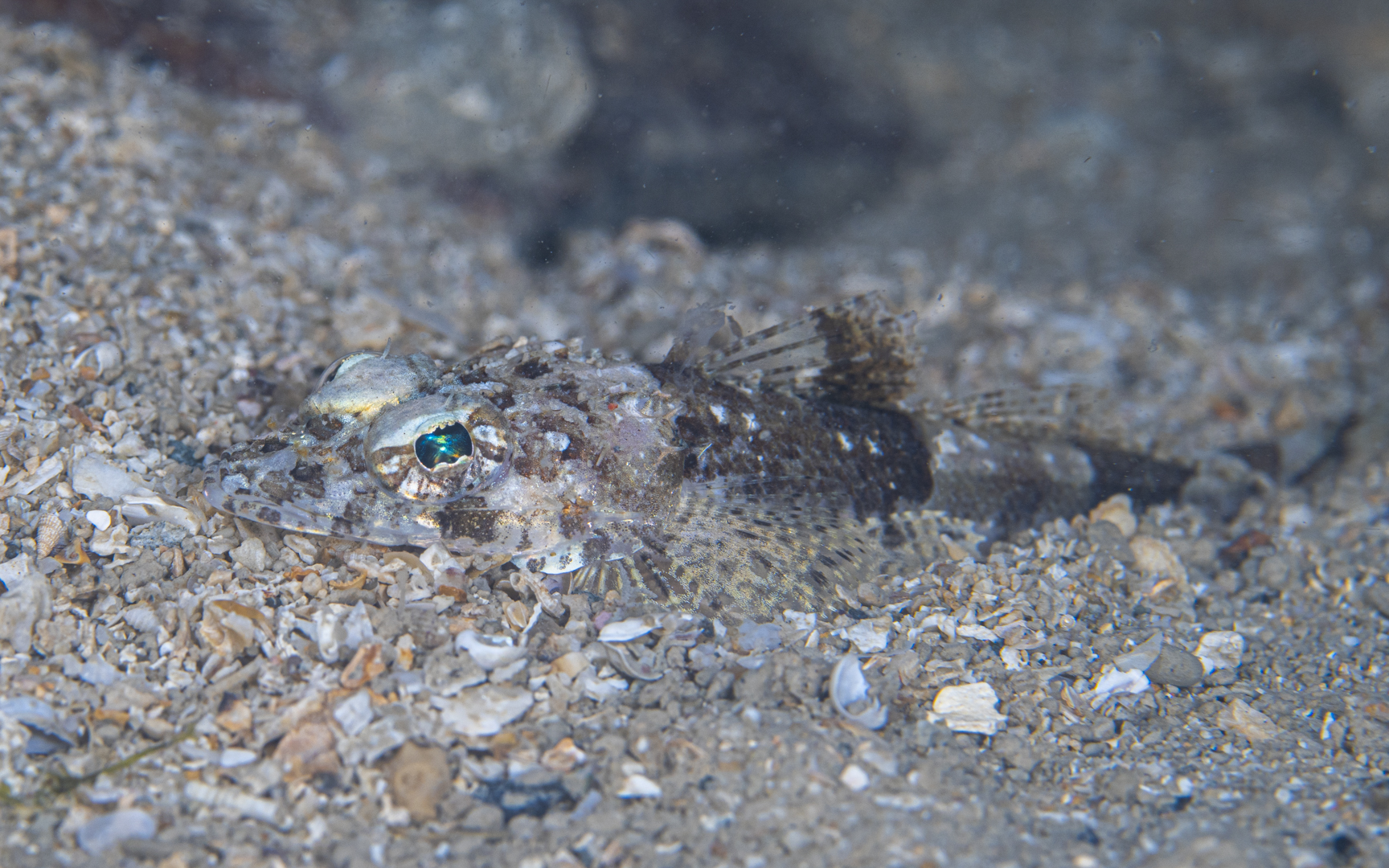
Thysanophrys celebica – セレベスゴチ
Scientific Name: Thysanophrys celebicaEnglish Name: Celebes flatheadObserved in: Pulau Hantu, SingaporeObserved Water Depth: Around 12mObserved Timing: Aug-22 セレベスといったらレンベのあるスラウェシ島の意であるが、当種を見た記憶はなく彼の地で一般的に分布しているのかはわからない。当地では幼魚と成魚をそれぞれ観察することができた。コチの仲間のことを、英語ではしばしばクロコダイルフィッシュと、勇ましい呼び方をするが、水底にじっとしていて、とても情けない顔をしている。 When it called ‘Celebes,’ it refers to Sulawesi, which includes Lembeh Island. However, I don’t recall ever seeing this species there, so I’m not sure if it is commonly distributed in that region. Nevertheless, I was able to observe both juvenile and adult fish in Singapore. In English, flathead family are often referred to as ‘Crocodilefish,’ giving them a fierce-sounding name. However, they actually look quite pitiful, sitting at the bottom of the water with a rather sorry expression on their faces
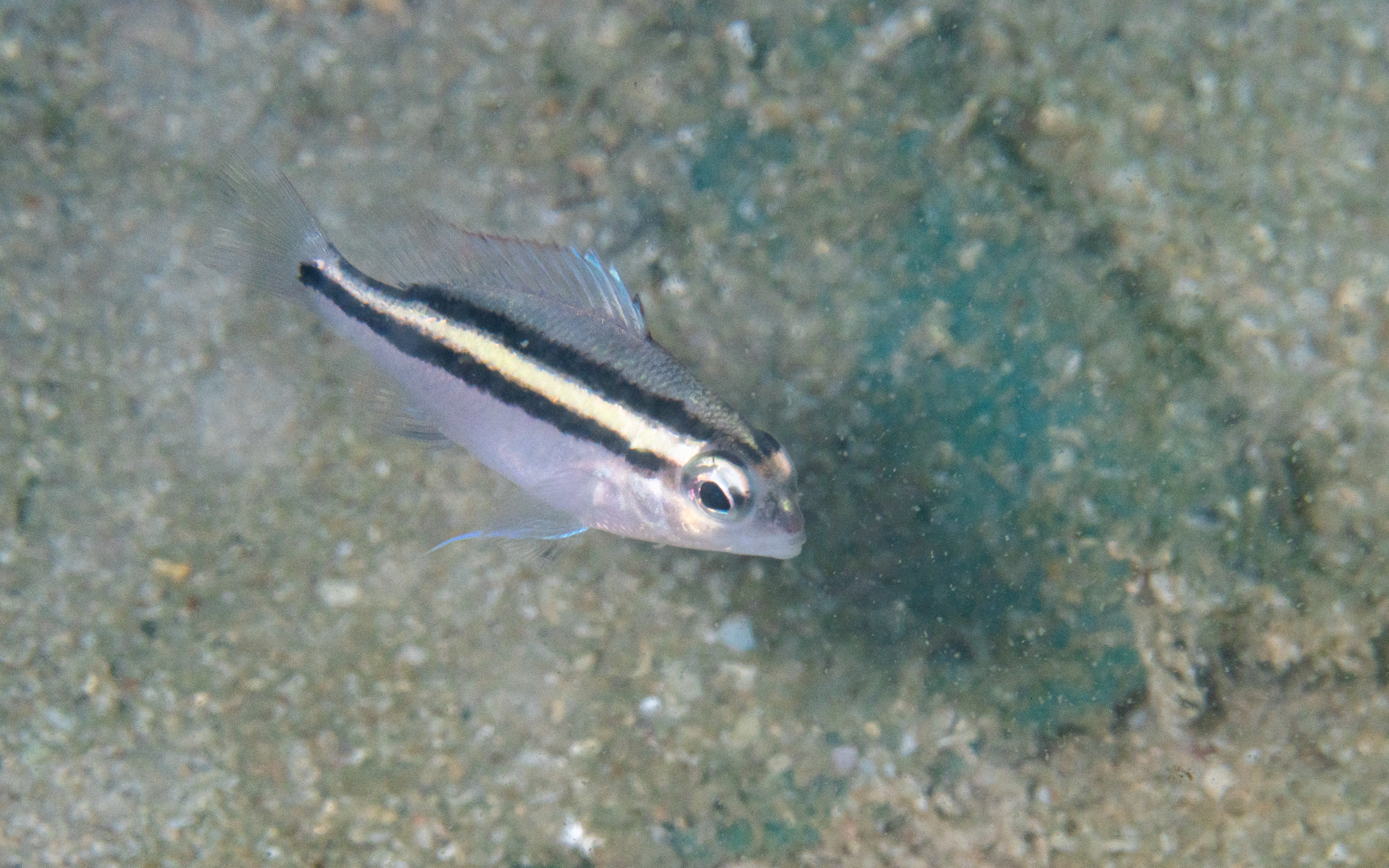
Scolopsis vosmeri – タイワンタマガシラ
Scientific Name: Scolopsis vosmeriEnglish Name: Whitecheek monocle breamObserved in: Pulau Hantu, SingaporeObserved Water Depth: Aound 10mObserved Timing: Nov-21, May-23 これまで気にも留めてこなかったタマガシラの仲間がシンガポールでは種々見られる。このタイワンタマガシラは恐らく珍しい種であり、いまだに1度しかみていない。そして1年半がたった2023年、目の前を成魚が泳ぎ去っていった。スズメダイに負けず劣らず体色が大きく変化するようだ。ひれを縁取る赤色に名残が認められるくらいか。 Honestly I do not remember well when I spotted it.I find Singapore has relatively many variety of Scolopsis genus, which I had not paid attention so much.This is juvenile and having simple black and white color, but it has also bright and shining blue on its fins.When it grows up, it turn to something another.
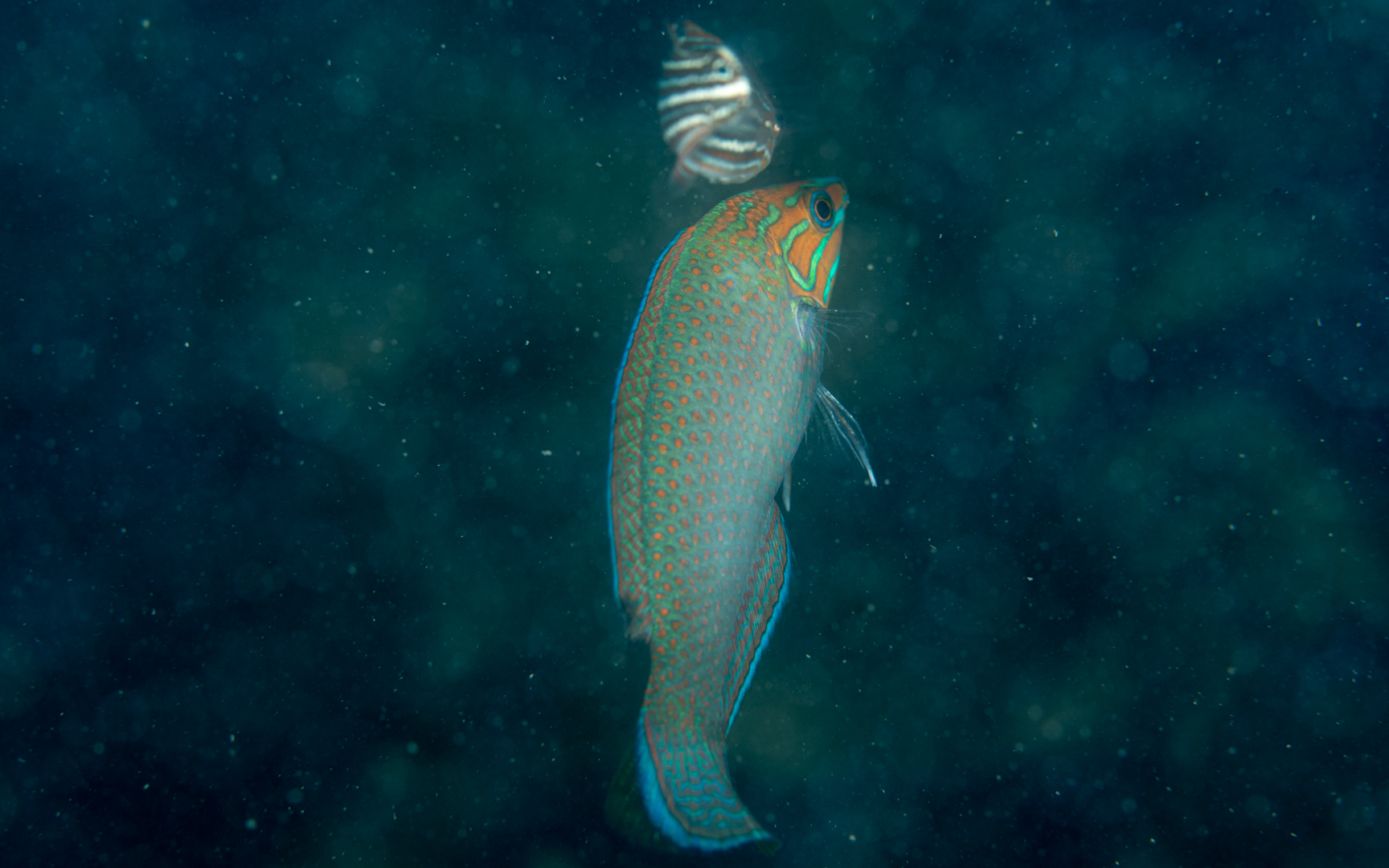
Halichoeres leucurus – アミトリキュウセン
Scientific Name: Halichoeres leucurusEnglish Name: Greyhead wrasseObserved in: Pulau Hantu, SingaporeObserved Water Depth: Around 12mObserved Timing: Aug-22 広範囲を動き回る被写体を撮るのに視界はやっぱり必要で突如として現れたベラなどに慌ててカメラを向けてシャッターを切っては見るものの、やっぱり写真にはならない。これも本来であれば掲載する類のものではないのだけど、アミトリキュウセンがシンガポールにいたという嬉しい驚きと、そして多分これ以上にいい写真は当地ではなかなか撮れないだろうから載せておく。 When capturing subjects that move around extensively, having clear visibility is undoubtedly necessary. When suddenly faced with a wrasse, I hurriedly aim my camera and press the shutter, but the photos never turn out as desired.These photos might not belong to the category meant for publication, but I couldn’t resist sharing the delightful surprise of finding Halichoeres leucurus in Singapore. Plus, I doubt I’ll be able to capture a better photo of it here anytime soon, so I decided to include it. Side Story photography 和名のアミトリは西表島の網取湾から。この二枚はまさにその命名の地で撮ったもの。まともな写真がまだ撮れていないことに気付いた。
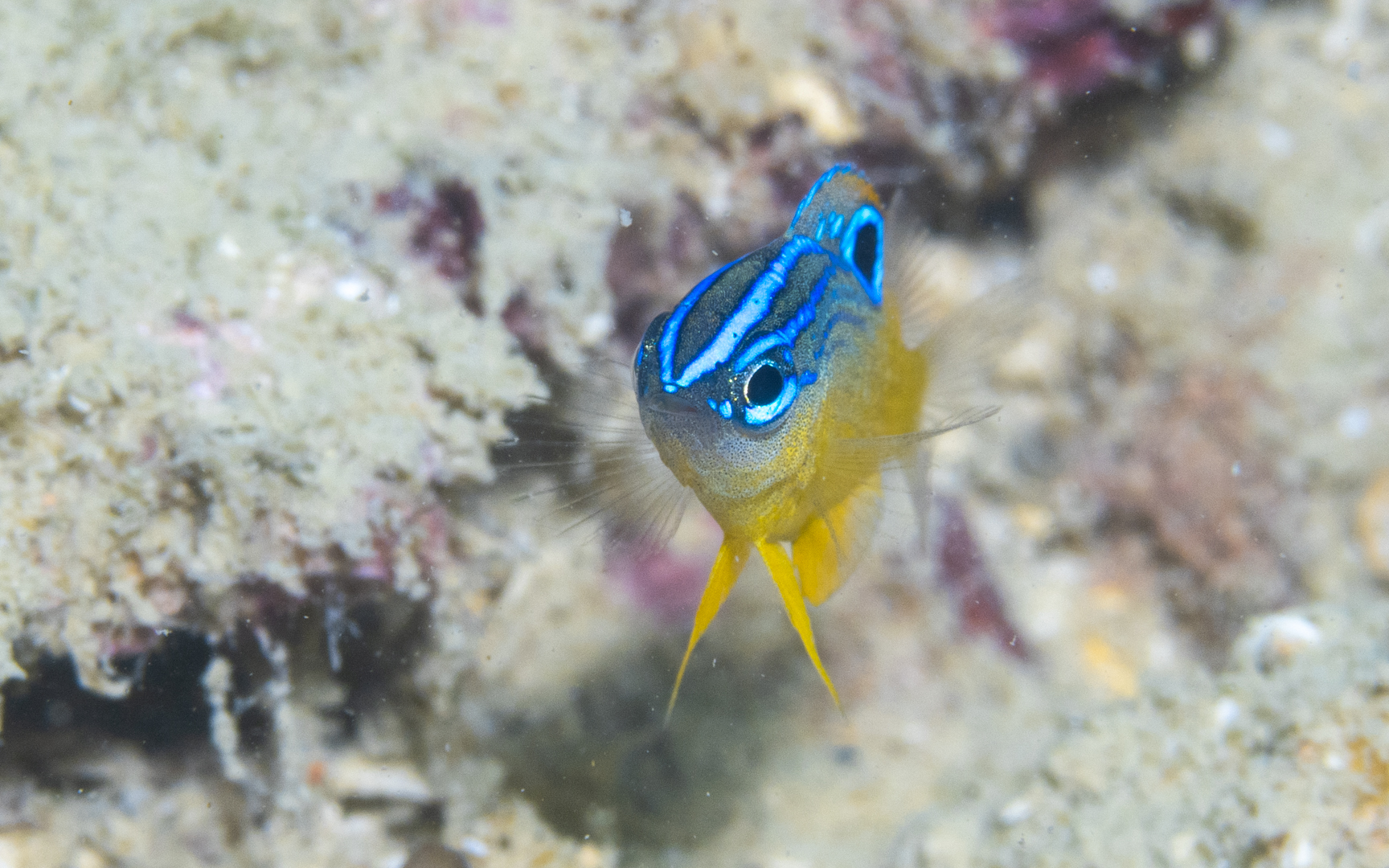
Pomacentrus simsiang – ブルーバックダムセル
Scientific Name: Pomacentrus simsiangEnglish Name: Blue-back DamselObserved in: Pulau Hantu, SingaporeObserved Water Depth: Around 12mObserved Timing: Feb-22 海に春を告げる出来事は様々あります。例えば、テンジクダイが口内保育を始めることであったり、卵を守るスズメダイに腕をつつかれることであったり。日本でいえば、アマミスズメダイ(スズメダイ属)の幼魚が出始めることもその一つ。そわそわした、どことなく心が落ち着かない雰囲気が海の中に溶けだしてくるんです。 同じようにシンガポールの海が春めきだしたのは2月、初めて本種の観察機会を得ました。属が異なりますし体型は違うのですが、額のVラインがアマミを彷彿とさせ、似ても似つかぬ浮遊物の嵐の海と、澄んだいつもの八重山の海を繋ぐ、なんだかそんな出会いをしたような気がしました。それにしてもスズメダイの幼魚はやっぱり綺麗で可愛いですね。 There are various events that herald spring in the sea. For instance, when Cardinalfish start practicing mouthbrooding or when Damselfish nudge you while protecting their eggs.In Japan, another sign of spring is the emergence of juvenile Chromis chrysura. The restless and somewhat uneasy atmosphere seems to dissolve into the sea. Similarly, Singapore’s sea began to feel like spring in February when I had the first opportunity to observe this juvenile. Although it belongs to a different genus and has a different body shape, the V-line on its forehead reminds me of…
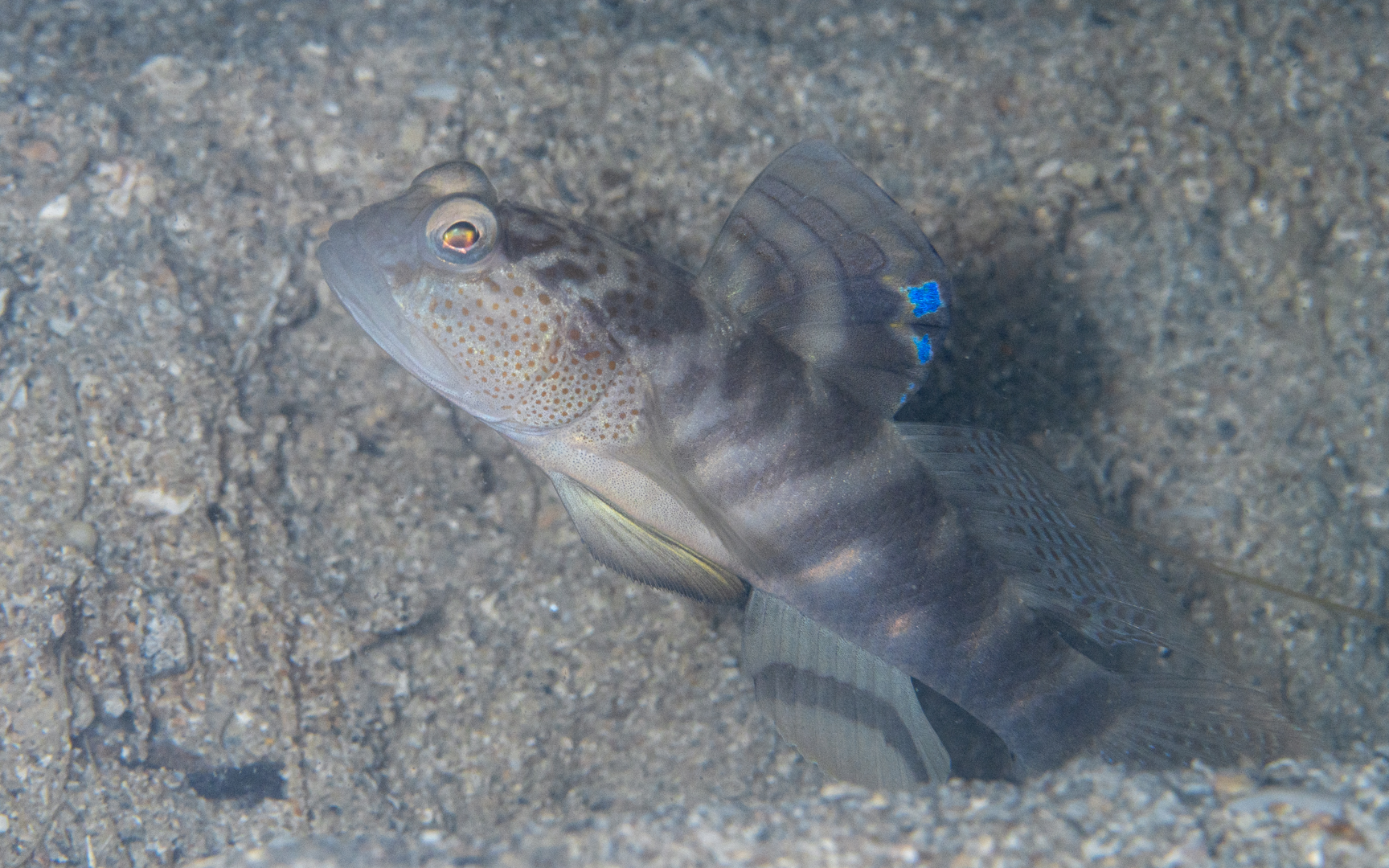
Mahidolia sp. – カスリハゼ属の1種
Scientific Name: Mahidolia sp.English Name: Flagfin goby sp.Observed in: Pulau HantuObserved Water Depth: 20mObserved Timing: Feb-22, May-23 水深20mくらいの斜面に共生エビとともにいたカスリハゼ属(1,2枚目)。生息環境から言えば、Mahidolia mystacinaなのかと思う一方で、第一背鰭の模様および、腹びれの模様はそれぞれsp.の特徴を有している。また、サイズ感もsp.のイメージに合致するように思います(mystacinaよりも大きい)。 This Flagfin goby has a lot of variety actually, while only two are registered officially.Since their fin shapes are different from Mahidolia mystacina, I categorized them as spices.Your suggestion on that is most welcomed ;)) Side Story photography 日本で見た河口域水深5mくらいに生息する本種。想像していた以上の大きさに驚いた。口が裂け気味で、血管(?)ムキムキ。
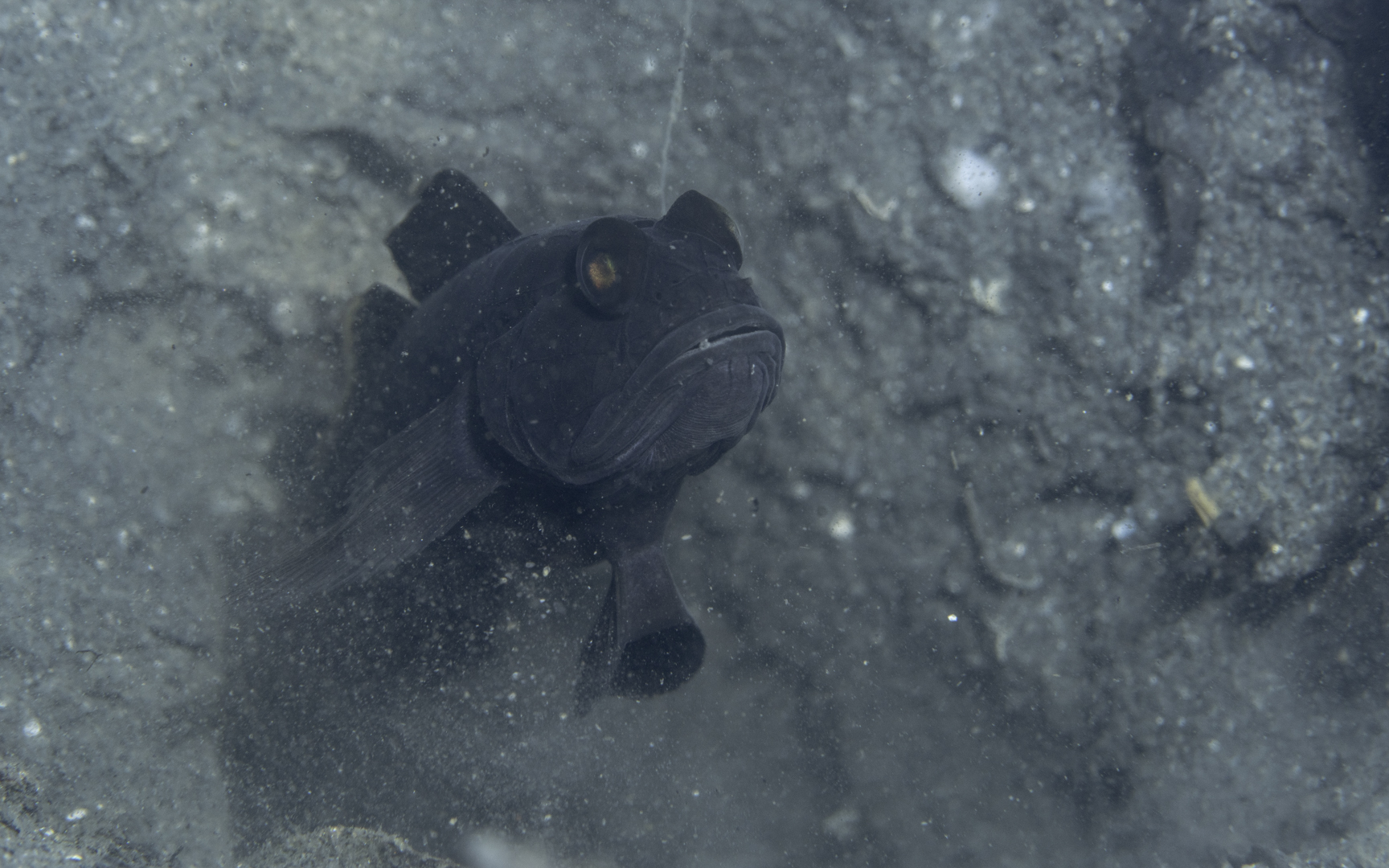
Mahidolia sp. – カスリハゼ属の1種
Scientific Name: Mahidolia sp.English Name: Flagfin goby sp.Observed in: SentosaObserved Water Depth: 3-5mObserved Timing: Mar-22 全身真っ黒なカスリハゼ。同属のハゼをPulau Hantuで確認しているが、体色や環境が異なるので別種ではないかと思われる。生息環境は水深3m。御伴のエビが巣穴から出入りする度に壁が壊れていき、あたりは煙幕を張ったようにもやもやしている。外敵から身を守る手段として意図的に行っているのか、おっちょこちょいなのかはわからない。ただ、撮影する側にしては試練でしかない。AFは当然機能せず、肉眼でも外形は陰としてしか把握できない中、勘を頼りにMF撮影した。枚数が撮れるデジタルってありがたい。 The entirely black flag-fin goby. I’ve observed in Pulau Hantu along with other gobies from the same genus. However, due to differences in body color and environment, it seems likely that they may belong to different species. Their habitat is at a 3m depth. Whenever their shrimp companions enter and exit their burrows, the walls crumble, creating a hazy atmosphere around them, as if smoke were spreading. It’s unclear whether this behavior is intentional as a means of protecting themselves from predators or if they are just clumsy. For photographers, it’s nothing but a trial. Autofocus is…
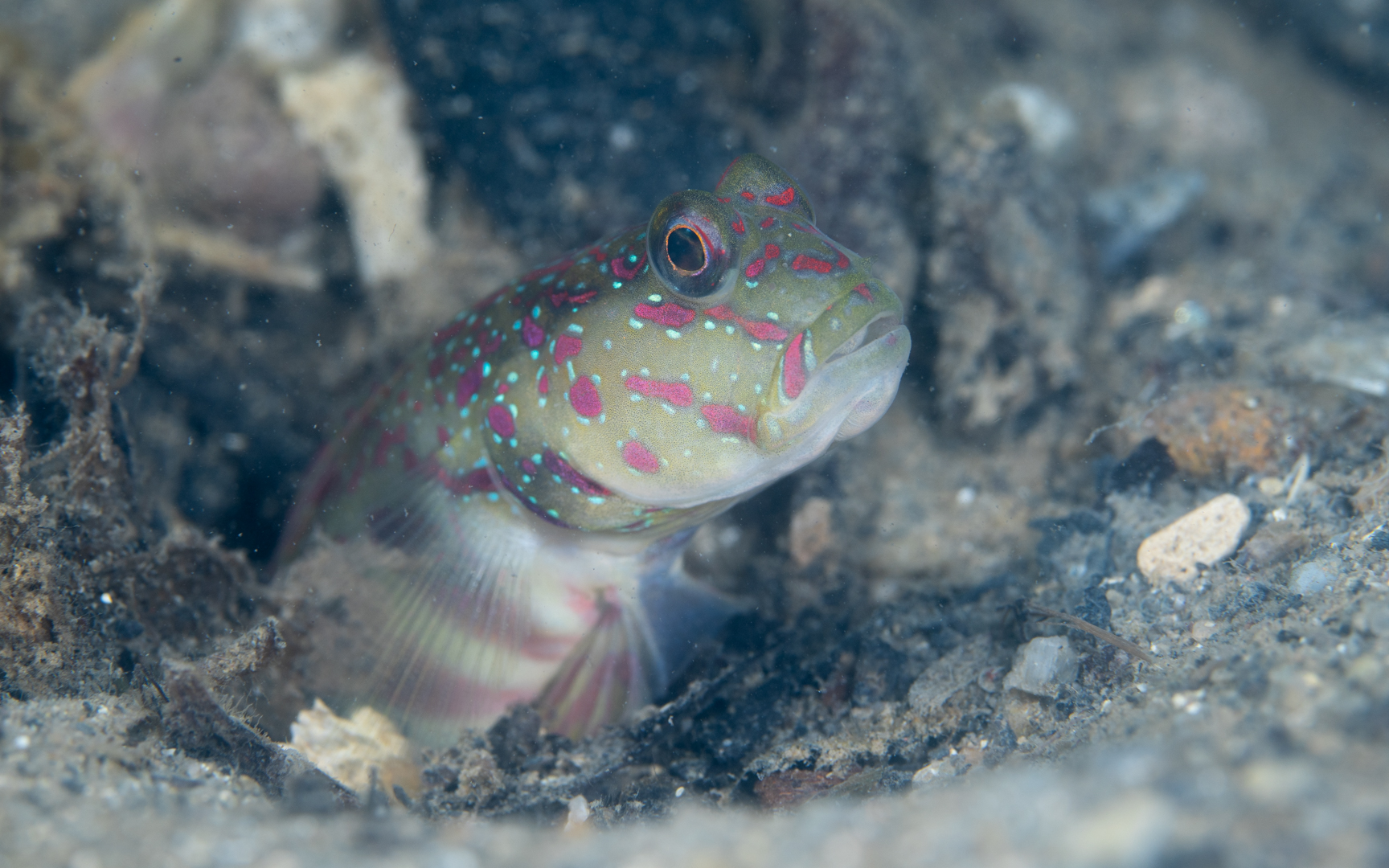
Cryptocentrus melanopus – オイランハゼ
Scientific Name: Cryptocentrus melanopusEnglish Name: Pink ShrimpgobyObserved in: Sentosa, SingaporeObserved Water Depth: Less than 5mObserved Timing: Anytime Pink color dot on the face and gorgeous fins, it is King of the Cryptocentrus. Or Queen rather since Japanese name is “Oiran” goby. It’s observed on a shallow sand together with its friend shrimp. If you are patient enough, you may observe its jump for a seconds, displaying purpose. By the way, it was freshy experience for me to see them on a dark colored sand with leaves and pebbles. 名前よろしくド派手なピンクのドットを顔面にあしらったこのハゼは、湾奥の河口域水深5mくらいの砂底に共生エビとともにみられる。シンガポールにおいても生息環境はおおよそ変わらないが、葉っぱの堆積した暗い色の砂でオイランを見ることは日本ではなかったため、非常に新鮮に思った。共生エビ(Alpheus rapax -トウゾクテッポウエビ)との共生の様子が写真からも確認できるが、エビは重たそうな小石をかき出さねばならず大変そうである。また、オイランといえばジャンプシーンであるけれど、素振りすら窺うことはできていない。そのタイミングについて詳しく伺ってみよう。 This goby, adorned with flashy pink dots on its face, can be found in the sandy bottom, about 5…
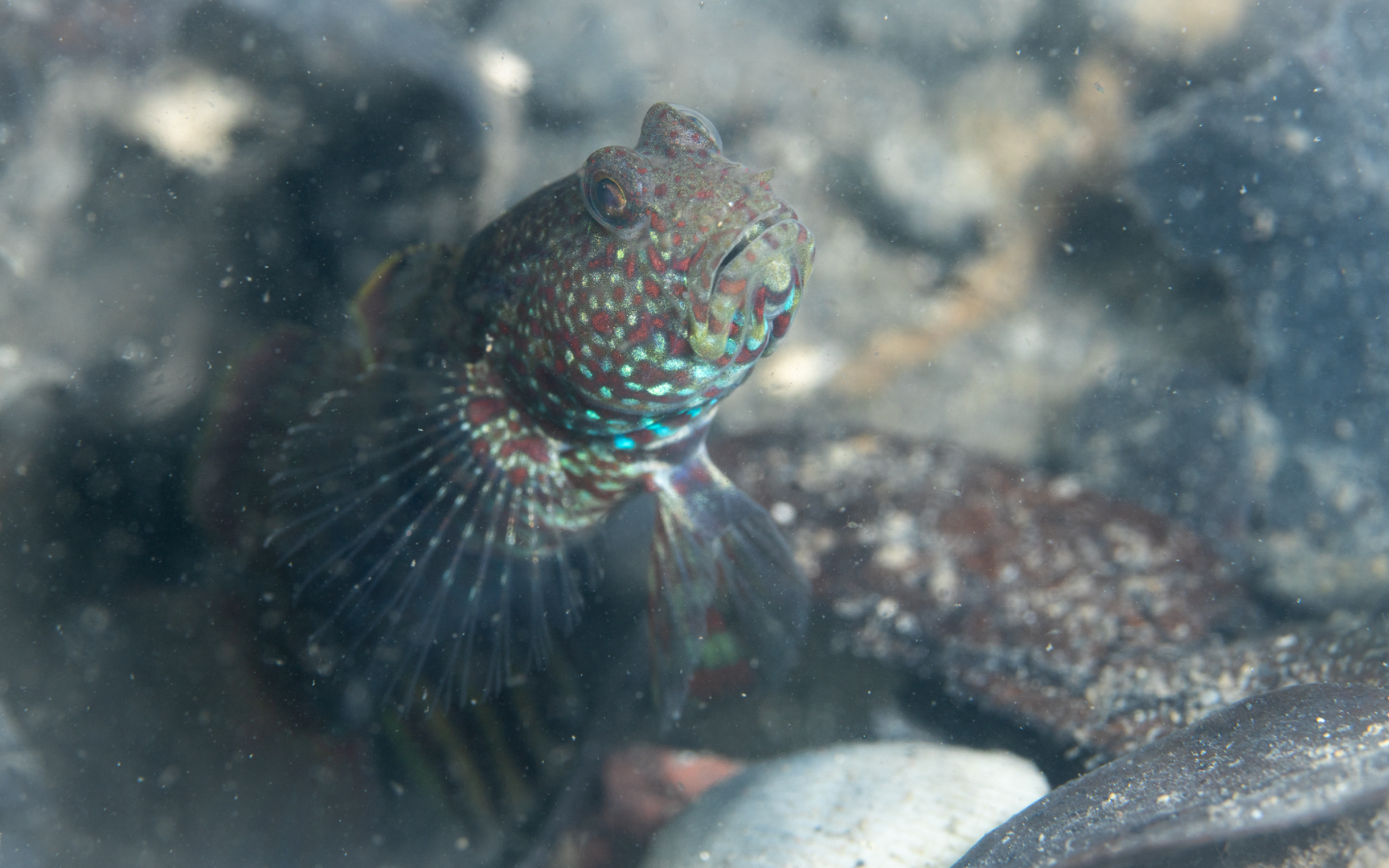
Cryptocentrus caeruleomaculatus – タカノハハゼ
Scientific Name: Cryptocentrus caeruleomaculatusEnglish Name: Blue speckled prawn-gobyObserved in: Sentosa, SingaporeObserved Water Depth: Less than 5mObserved Timing: Anytime 写真に撮ってみないとわからないことが確実にある。1つは観察時点では意識が向いていなかったが、後から眺めてみると気付けた、という類のもの。これは観察の回数を増やすことで相対的に減っていく(つまり、水中で気付けることが増えてくる、、ようになりたい!!)。 その一方で、どうしたって肉眼では確認できないという人間の限界的なところをカメラが助けてくれるということもある。当種は一見地味で、水中で見ると白黒で、頭部周辺の模様の特徴からMaudae Shrimpgobyと見間違えそうになるのだけど、フラッシュをたいて写真に収めてみると、青や赤のドットがちりばめられてることに気づかされる。個体数も多いし、見向きもされていない気がするけれど綺麗です。 There is definitely something which never know unless photograph. One of that is underwater has a remarkably full of colors. As deeper we dive, a scenery lose the sun light and it makes the underwater world more like monotonic blue world. I would say it is also nice and unique. However, it is also fun to find a shining green in the goby body, or a bright pink on the rocks.It’s the joy of nature observation with a camera.
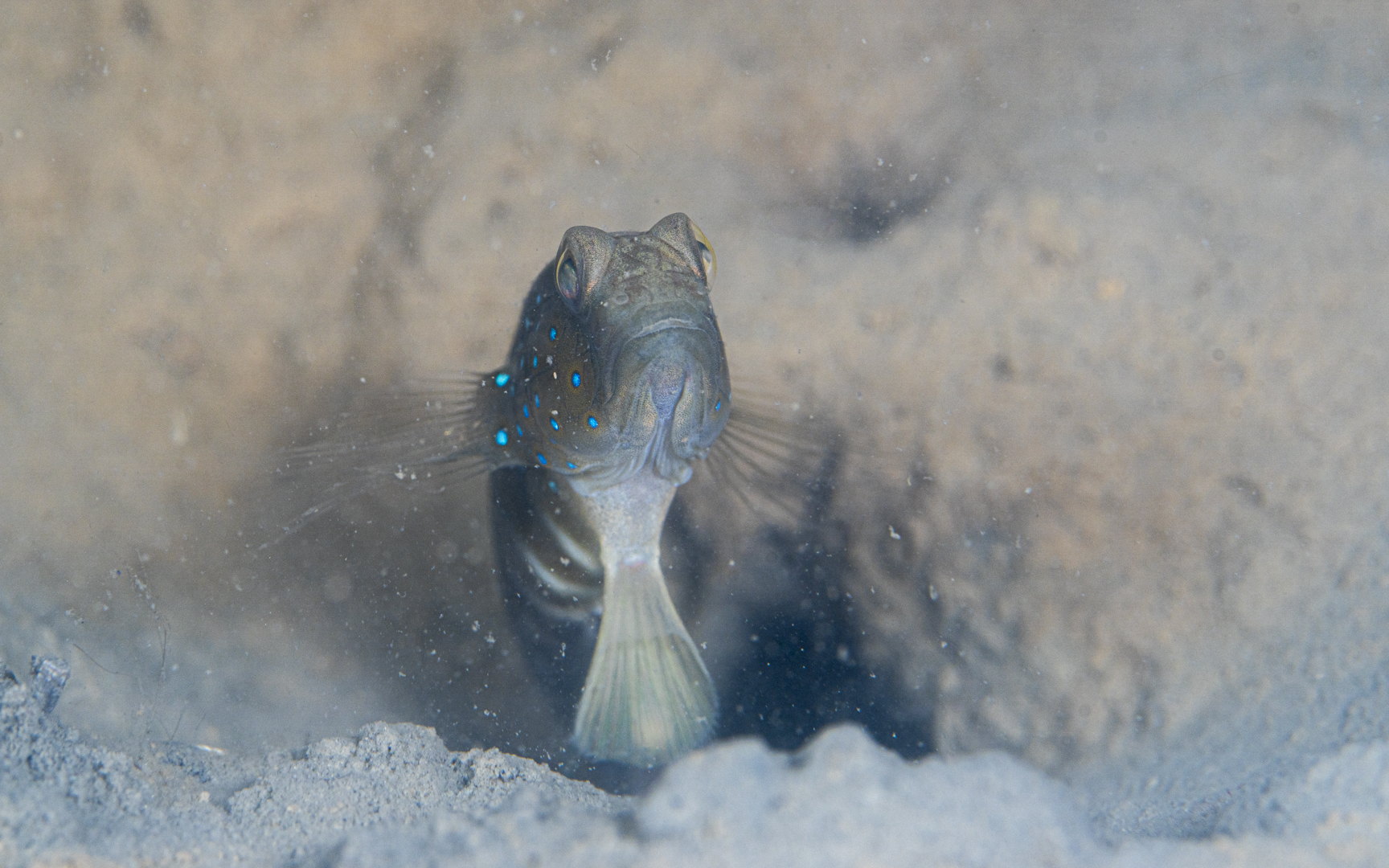
Cryptocentrus cyanospilotus – ホシゾラハゼ
Scientific Name: Cryptocentrus cyanospilotusEnglish Name: Bluespot ShrimpgobyObserved in: Sentosa, SingaporeObserved Water Depth: Around 7mObserved Timing: Feb-23 これまでよく探索してこなかった場所にフカフカのシルト泥の環境を見つけた。少し動けばたちまち煙幕を張ってしまうその環境には、これまで当地では見てこなかった様々なハゼがいた。このホシゾラハゼもその1種。散りばめられた青い点が輝いている。私にとっての初見は西表島であり、あまり巣穴から出てこない臆病なイメージがあったけれど、当地では活発に採餌に勤しんでいた。 I found a soft, silty environment in a place I hadn’t explored much before. The moment I moved, the whole area became a haze of sediment. In this environment, I encountered various gobies that I had not seen in Singapore. This goby is one of them. It shines with embedded blue spots.My first encounter with this species was in Iriomote Island Japan, where I had an image of them being timid and rarely coming out of their burrows. However, here, they were actively foraging and seemed more lively.
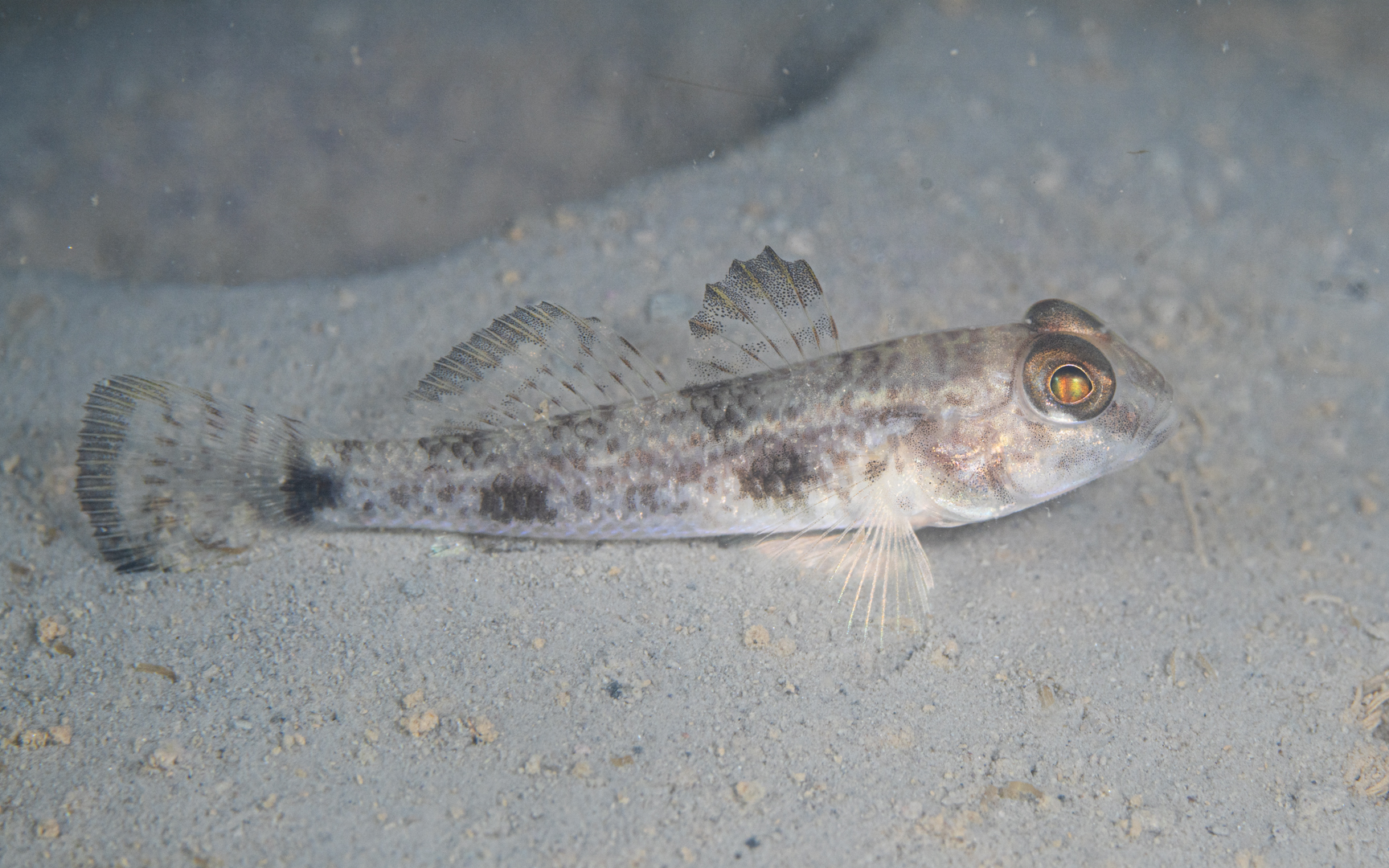
Yongeichthys criniger – ツムギハゼ
Scientific Name: Yongeichthys crinigerEnglish Name: Yellowfin Toxic GobyObserved in: Sentosa SingaporeObserved Water Depth: Less than 5mObserved Timing: Jun-22, Feb-23 ツムギハゼ。初めて見たのは石垣島の河口域、トントンミーが行き来するマングローブの浅瀬に数多く生息していた。英名にあるように有毒であり、それはテトロドトキシンである。その昔は田んぼに撒いて害獣駆除にしていたとか。。そんなツムギハゼ、当地にはセントーサの港内に生息しており2022年に証拠写真を収めて以来出会わなかったが、2023年改めて探索してみると、水深7メートル近くのシルト泥の底を数匹が行きかっているのを確認できた。 I first saw it in the estuary of Ishigaki Island, where many of them inhabited the shallow waters among the mangroves. As its English name suggests, it is poisonous, containing tetrodotoxin. In the past, it was used to eliminate pests by spreading it in paddy fields. Since capturing it in a photograph in Sentosa’s harbor area in 2022, when I revisited in 2023, I could confirm several of them swimming near the silted bottom at a depth of around 7 meters. .
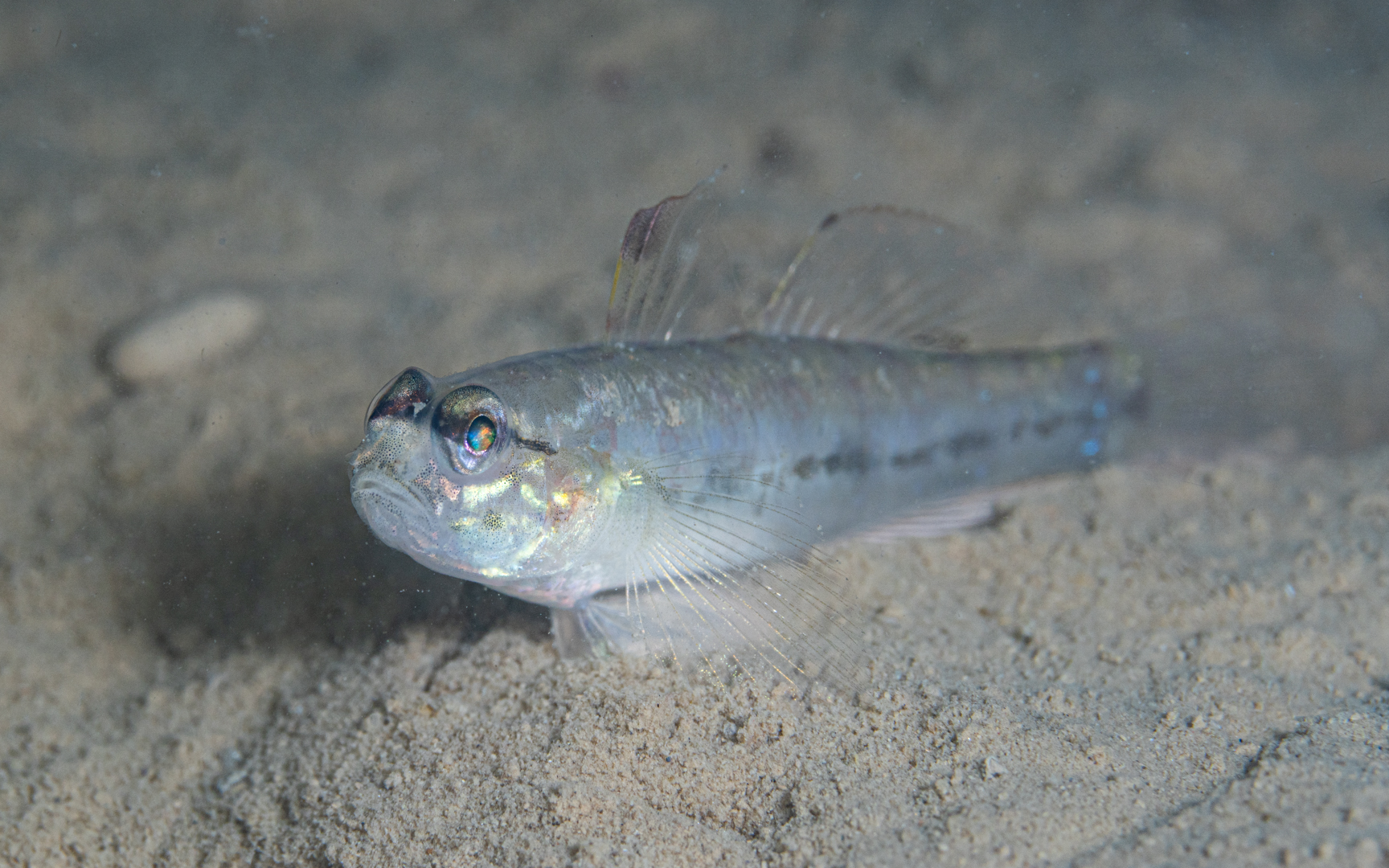
Gobiidae sp. – ハゼ科の1種
Scientific Name: Gobiidae sp.English Name: Goby sp.Observed in: SentosaObserved Water Depth: Around 7mObserved Timing: Feb-23 2022年前半は国外への渡航に制限が掛かっていたので、シンガポールの海を集中的に探索したものの、国境が開いてからは足が遠のいてしまっていた。そうして2023年になり、久しぶりに潜ってみると初見のハゼがまだまだいた。当種は、ほんの少しでも接触してしまえば、たちまち濁るような非常に細かい軟泥にいたハゼ科の1種。当地で観察されていそうなハゼ科の魚類を総当たりしてみたが、該当するような記載は見当たらなかった。属の検討もつかない、、、。目の脇から延びる線、とぎれとぎれの縦帯、第一背鰭の黒斑、尾鰭近くの輝青点。。数匹いた。 Oversea Travel is restricted during the pandemic, I explored the sea of Singapore. After opening the border, it get drastically reduced diving this sea. However, I would say there were still many incredible first time encounters.This species is a gobiidae found in very fine ooze where instantly turns cloudy if even the slightest touches on it.I browse all the gobies that are likely to be observed in Singapore but no hit.It has a feature like, a line extending from the side of its eyes, an intermittent vertical band at the center of its body, a black spot on the…
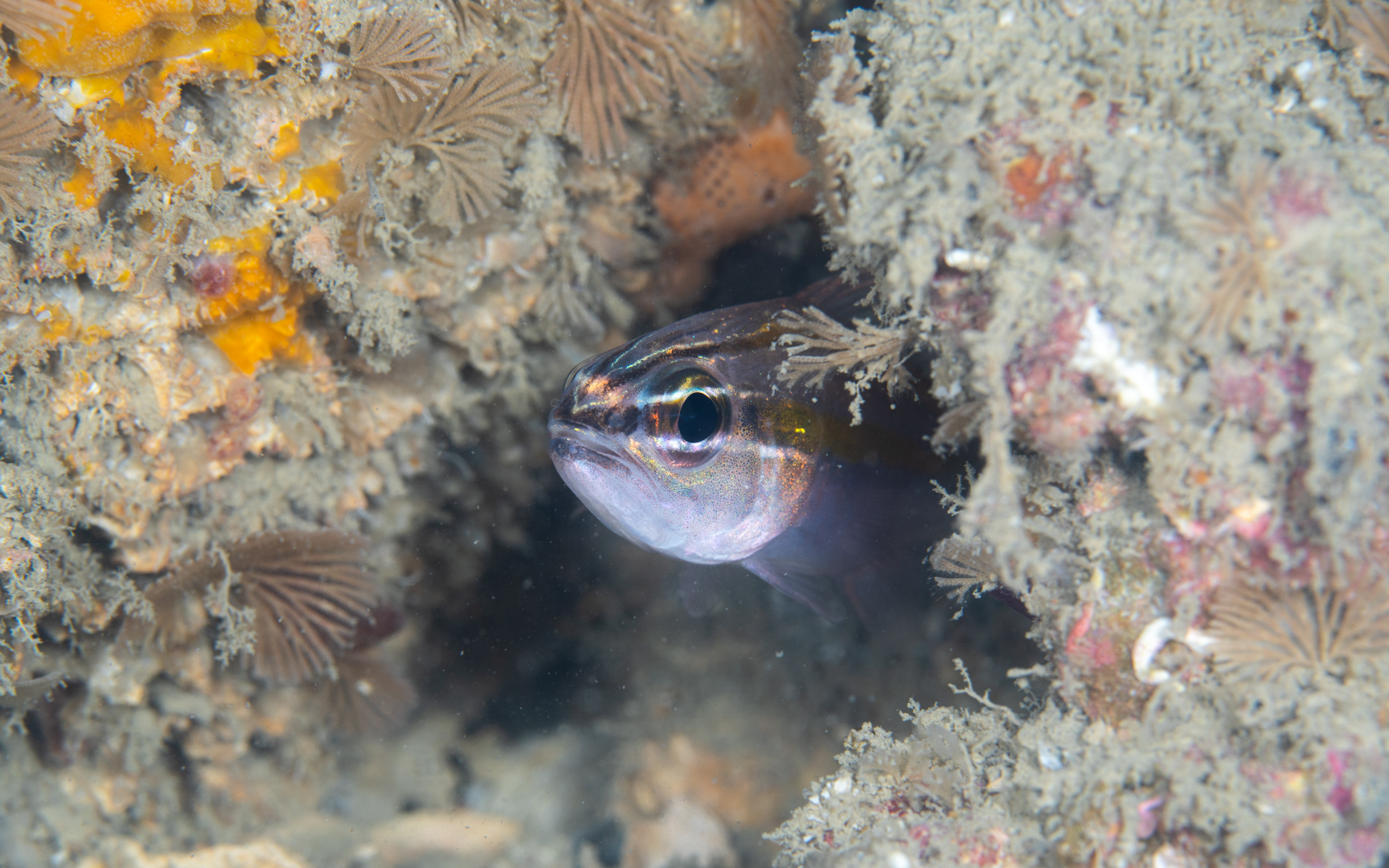
Ostorhinchus cavitensis – ホワイトラインカーディナルフッシュ
Scientific Name: Ostorhinchus cavitensisEnglish Name: Whiteline CardinalfishObserved in: Pulau Hantu, SingaporeObserved Water Depth: Around 10mObserved Timing: Anytime I often find something like a universe, when I develop a cardinalfish photography. Their shining body looks like a star or galaxy. This species has bright yellow line and that beautifully emphasize this inner universe. 透き通った体にきらきらと輝くテンジクダイ科の魚たち。本種はレモンイエローの差し色付き。日本には生息しておらず、和名は見つけられなかった。英名はWhiteline Cardinalfishであるが、この美しいYellowではなく、そっちに注目するのか??命名とはなかなに奥深い作業のよう。 Glistening with a transparent body, the fish of the Cardinalfish family shine brightly. This species is adorned with lemon-yellow accents. It does not inhabit Japan, and I couldn’t find its Japanese name. Its English name is White-line Cardinalfish, but I wonder why the focus is not on its beautiful yellow color instead? Naming seems to be a truly profound process.…
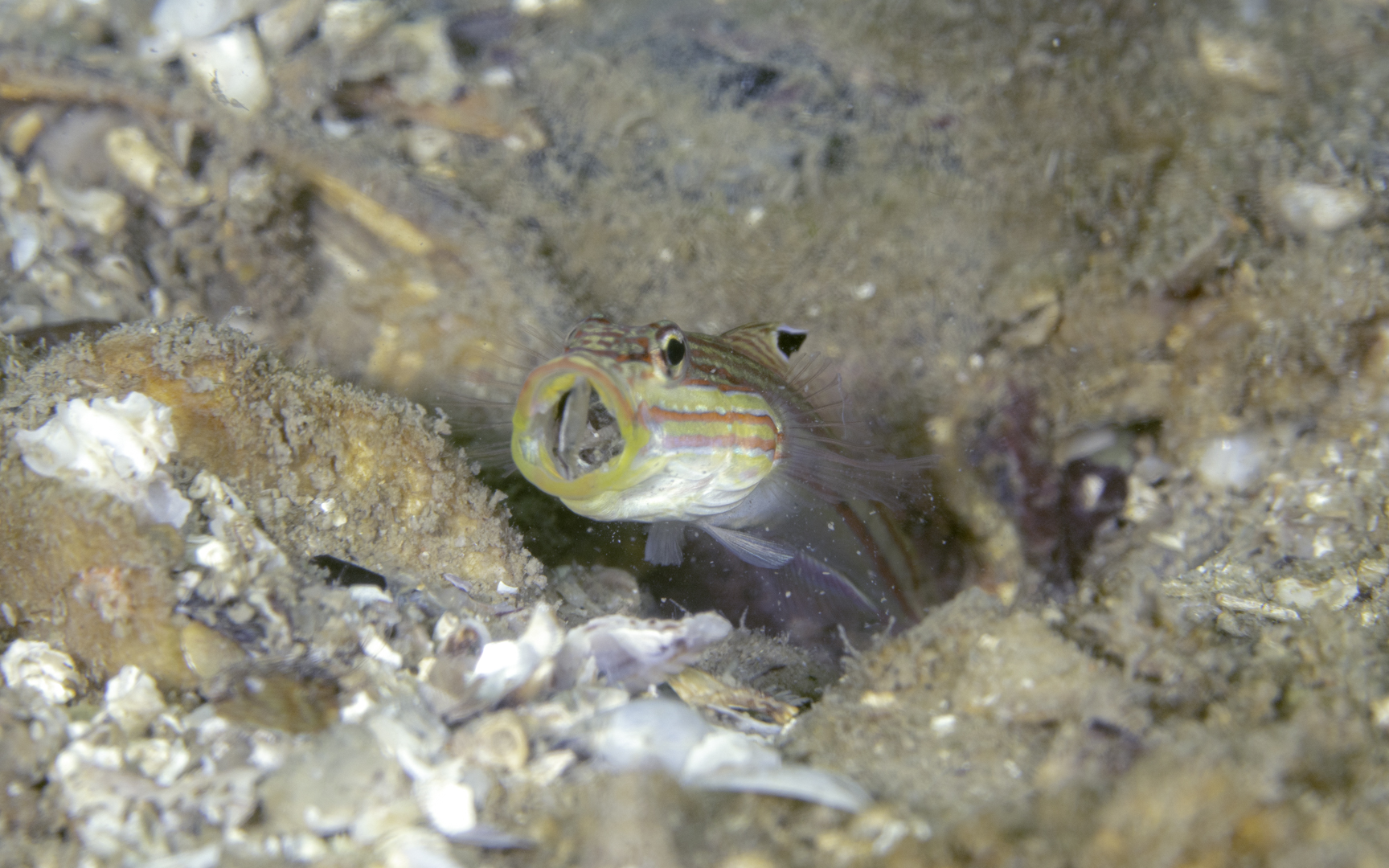
Valenciennea muralis – ムラルゴビー
Scientific Name: Valenciennea muralisEnglish Name: Mural GobyObserved in: SentosaObserved Water Depth: Less than 5mObserved Timing: Feb-23 当地の海を潜り出してから1年以上が経過したが、まだまだこの海は新しい発見をさせてくれる。当種はムラルゴビー、クロイトハゼ属の1種でありイマキュレートゴビーに似るが第1背鰭の黒斑の有無などで区別が可能。幼魚は島内ラグーンとをつなぐ水路の入り口で巣穴整備に勤しんでいた。強めの流れが土砂を絶え間なく流入させるし、共生エビもいないので大変だ。なぜこんな場所に巣穴を作ったのか不思議になる。少し離れた場所では成魚がペア行動をしていた。離れ離れになっても、しばらくするとスッと行動を共にし出すのが不思議。一方の私はパートナーを必死にダイビングベルで呼んでもなかなか来てくれないのに。 It past over one year since my first dive in here in Singapore, however, it still bring something new for me.This is Mural goby can be distinguished from Immaculate goby by the black spot on first dorsal fin.Juveniles is working hard to maintain its burrows. It looks really tough because strong current constantly carries earth and sand into it, and also no help of shrimp is expected for this species. How come this guy decided to have its home in such the place..Proceeding bit forward, then its adult was found in pair. Even they get separated, after some…
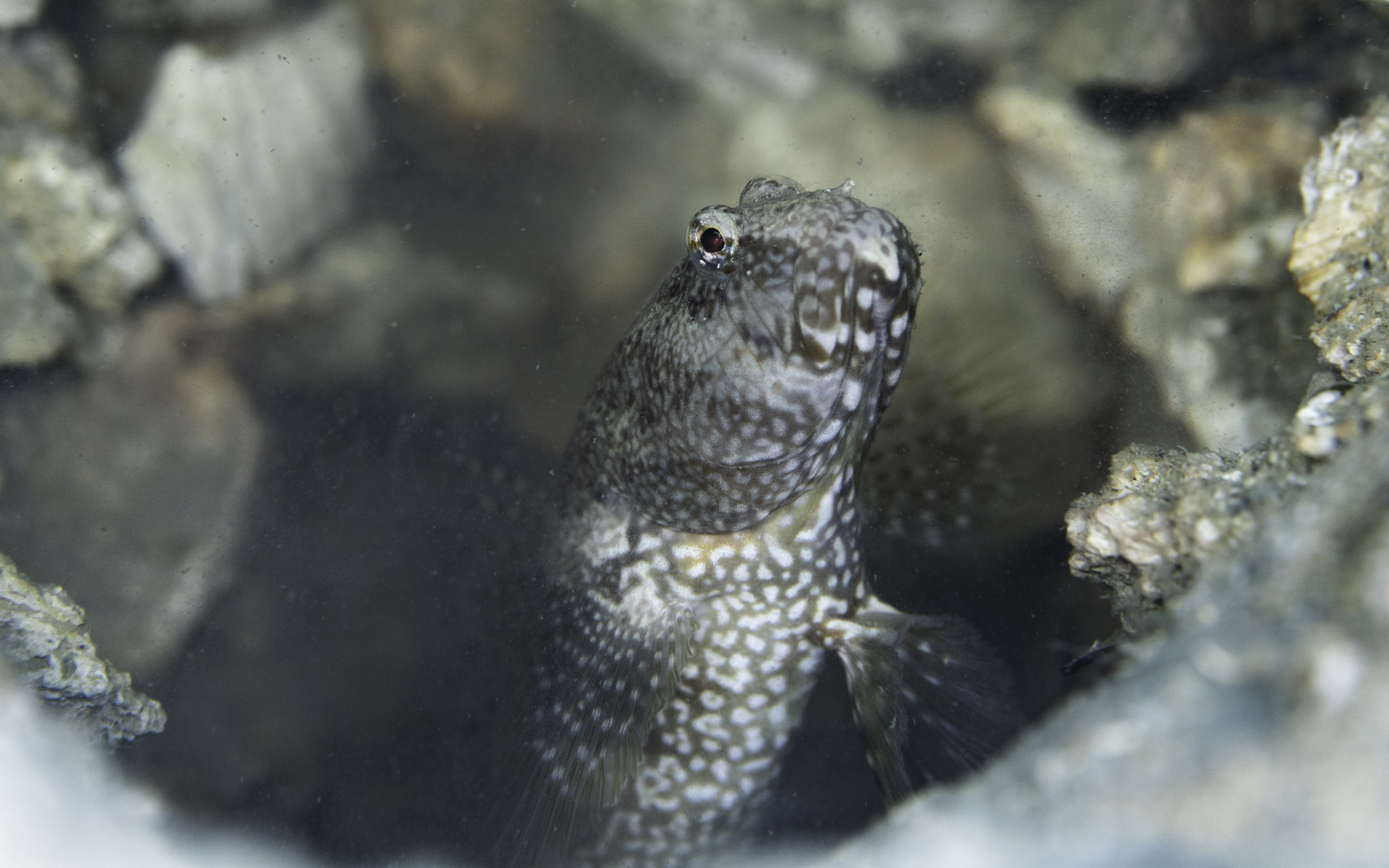
Cryptocentrus maudae – マウダエゴビー
Scientific Name: Cryptocentrus maudaeEnglish Name: Maudae ShrimpgobyObserved in: Pulau Hantu, SentosaObserved Water Depth: Around 10-15mObserved Timing: Anytime 主に10m以浅に多く生息している、とても一般的な種であるが、とても敏感なので慎重なアプローチが必要。同属のフタホシタカノハハゼは割と雑に近寄っても引っ込まない。観察日が同じであっても、種によって、そこら辺の違いがあるのがとても興味深い。当種の幼魚は一見シロオビハゼっぽいが、背中の白いラインが途切れることで区別ができる。成魚は10cmを超える大きさまで成長している個体も見られ、顔周りの模様が独特で面白い。 This is one of the dominant species of Singaporean sea about Gobiidae.It is more common in Pulau Hantu area, than Sentosa where Cryptocentrus caeruleomaculatus is the one instead.Juvenile is tiny and living with also tiny shrimp. Growing up certain large size, it get difficult to shoot with 100mm class macro lens.It has complexed coloring and design.White band just after its eyes, seems to be separated as grown up.

Lutjanus carponotatus – スパニッシュフラグスナッパー
Scientific Name: Lutjanus carponotatusEnglish Name: Spanish Flag SnapperObserved in: Sentosa, SingaporeObserved Water Depth: Less than 5mObserved Timing: Sometime セントーサの浅瀬を行き来しているフエダイの仲間。良い環境で撮れればもう少し綺麗なのかもしれないが、写真の質としてはここら辺が限界かなぁ。
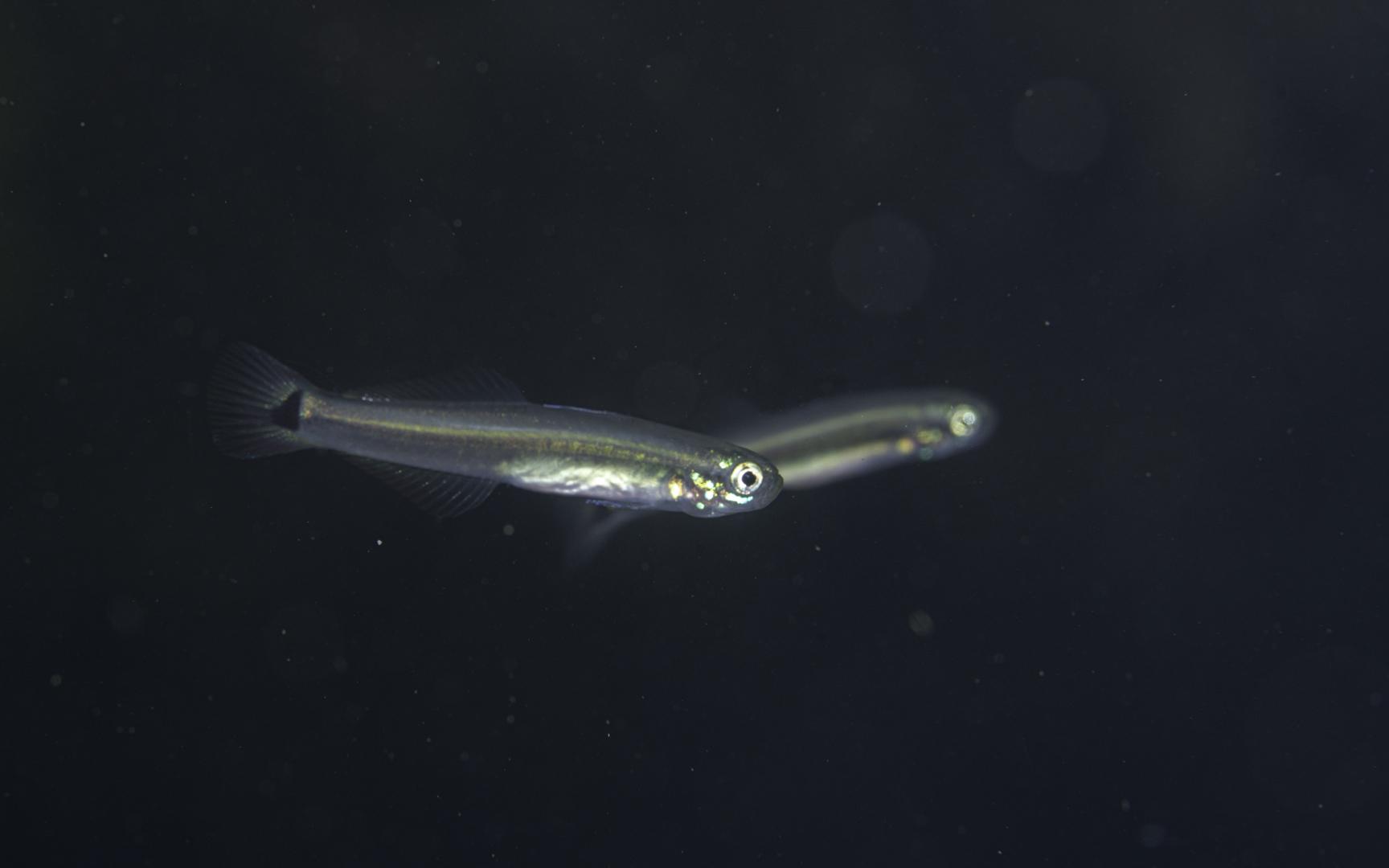
Parioglossus rainfordi – コビトハゼ
Scientific Name: Parioglossus rainfordiEnglish Name: Rainford’s dartfishObserved in: Sentosa, SingaporeObserved Water Depth: Less than 5mObserved Timing: Feb-23 久しぶりにセントーサで潜ってみると、桟橋すぐ下に3匹でひらひらと泳ぐサツキハゼ属の何かがいた。おそらくコビトハゼの雌と思われ、尾鰭基底に三角形の黒斑を特徴とする。
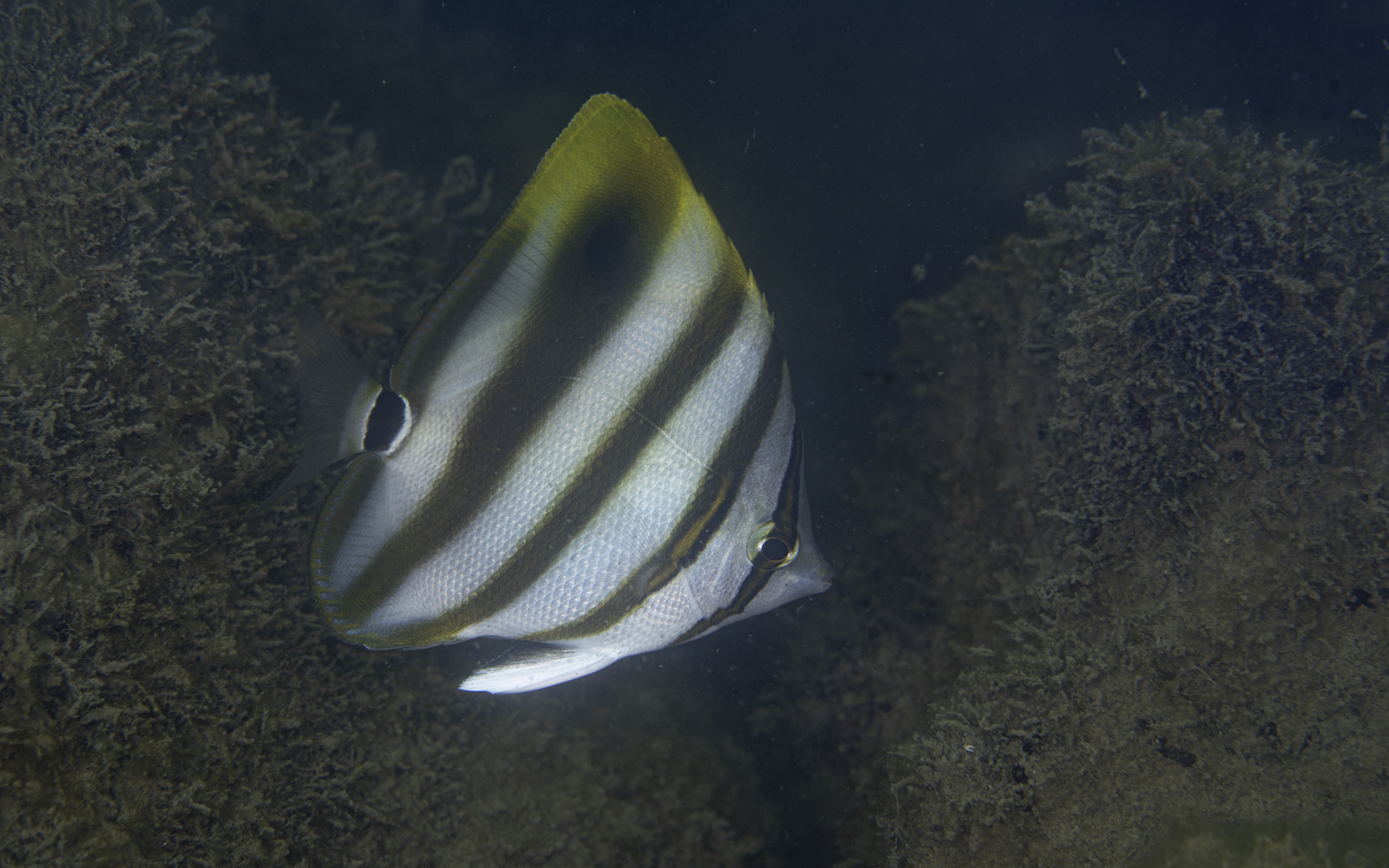
Parachaetodon ocellatus – テンツキチョウチョウウオ
Scientific Name: Parachaetodon ocellatusEnglish Name: Sixspine butterflyfishObserved in: Sentosa, SingaporeObserved Water Depth: Less than 5mObserved Timing: Mar-22, Feb-23 チョウチョウウオを真面目に撮ったことは殆どなかった。どこかありふれた感じがして興味が沸かないのと、100mmクラスのマクロレンズの被写体としては大きすぎる。しかしこうして、サイトに当地の魚類の様子を纏め始めたのをきっかけに、割と分け隔てなく魚類の観察するようになった。これまで注意を払っておらずに見過ごしてきた世界が、まだまだ奥深く広がっていることに気づかされる。果てしない。
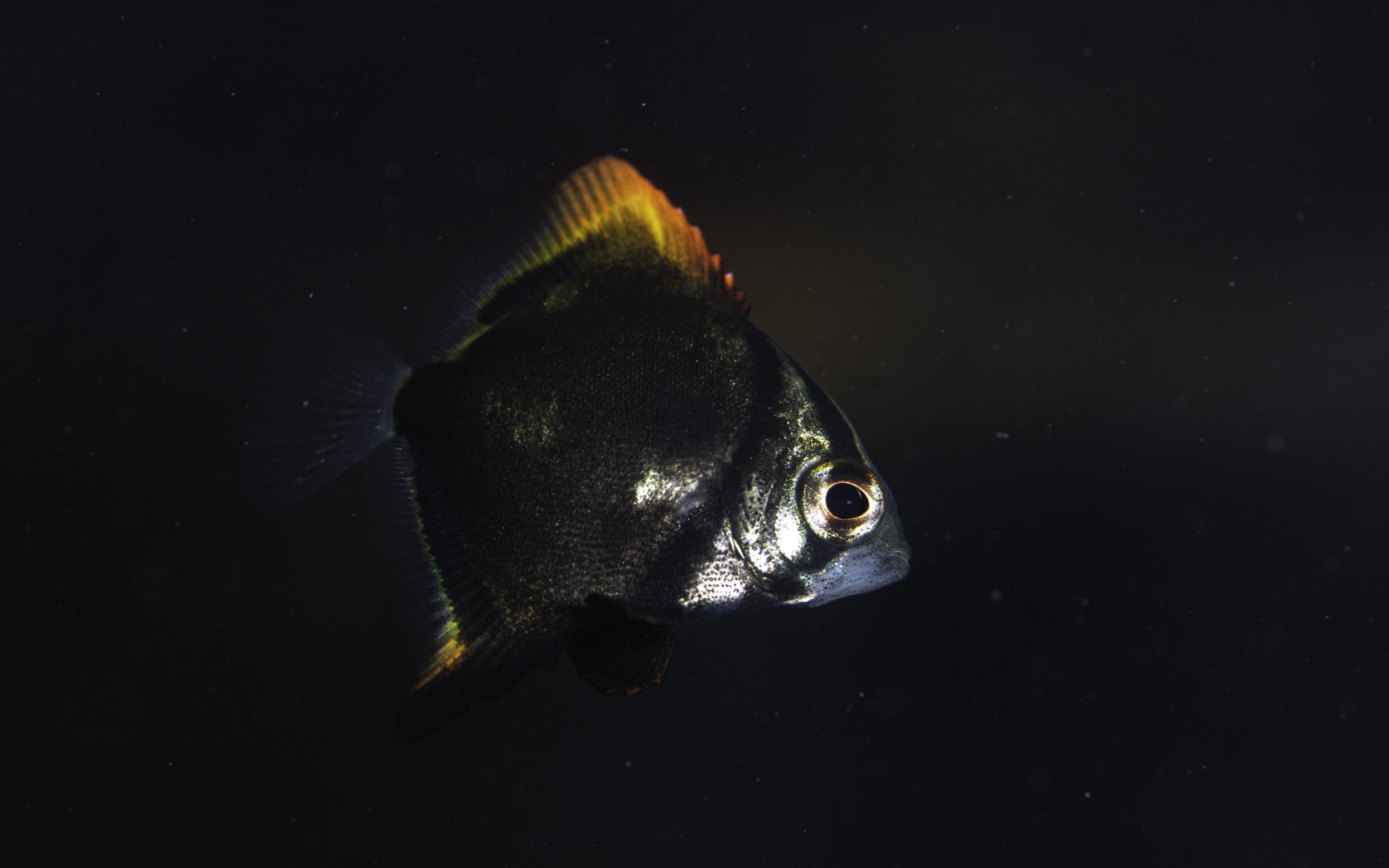
Monodactylus argenteus – ヒメツバメウオ
Scientific Name: Monodactylus argenteusEnglish Name: Silver moonyObserved in: Sentosa, SingaporeObserved Water Depth: Less than 5mObserved Timing: Sometime 港の桟橋下水深数十センチに浮いているヒメツバメウオ。常時見られるわけではない。汽水域にいるものだと思っていたが、海水を生息環境にもするらしい。成魚は見られず別の場所にいるようだ。 体色が黒っぽいのと白がかった個体を見つけることができたが、成長段階による違いなのだろうか。成魚は英名の通り銀色ベースの体色に明るい黄色の背鰭を持つとても綺麗な格好となる。 Swimming near surface. This bright orange dorsal fin turn to more yellowish one as growing up.Size is around 1cm.
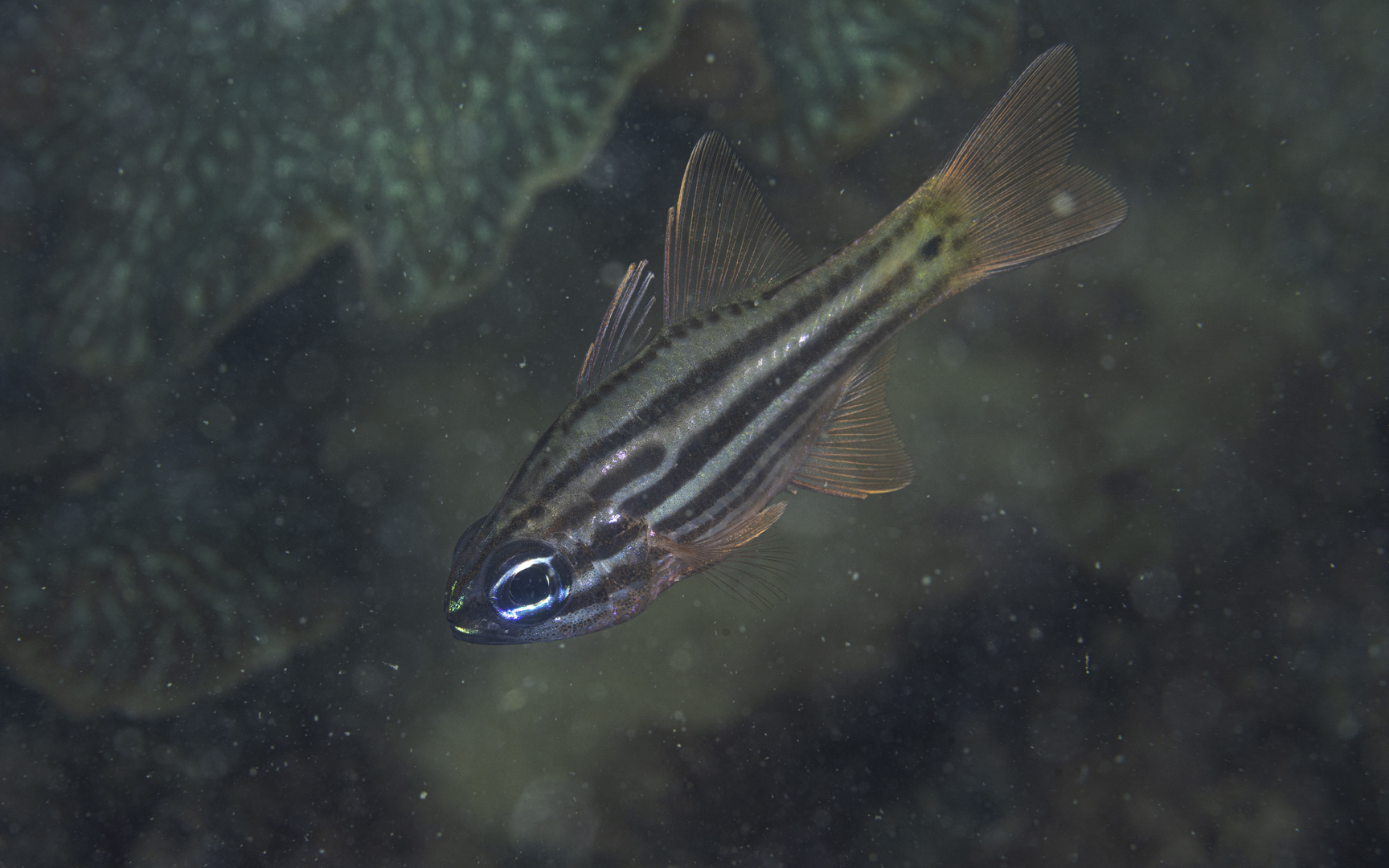
Ostorhinchus compressus – ヒラテンジクダイ
Scientific Name: Ostorhinchus compressusEnglish Name: Ochre-striped cardinalfishObserved in: Pulau Hantu, SingaporeObserved Water Depth: Around 5-10mObserved Timing: Aug-22 青くメタリックに光る眼と淡いピンク~オレンジの鰭の取り合わせがなんとも綺麗なテンジクダイ。浅瀬をうろうろしているから簡単に撮れそうなもんだけど、すっと向きを変えてそっぽを向こうとする。良いアングルで撮るには追いかけまわさずにゆっくりと待つことです(自戒)。 Another Observation 写真左は西表で撮影したもの。海が濁っていないので、体色がよくわかるかと思います。写真右はセブでの撮影。鰭全開で口を開けているが、テンジクダイがこのようになっているのはあんまり見かけない、、、と思ったら案の定抱卵しているじゃないか(水中で気付けよ。。。泣)。
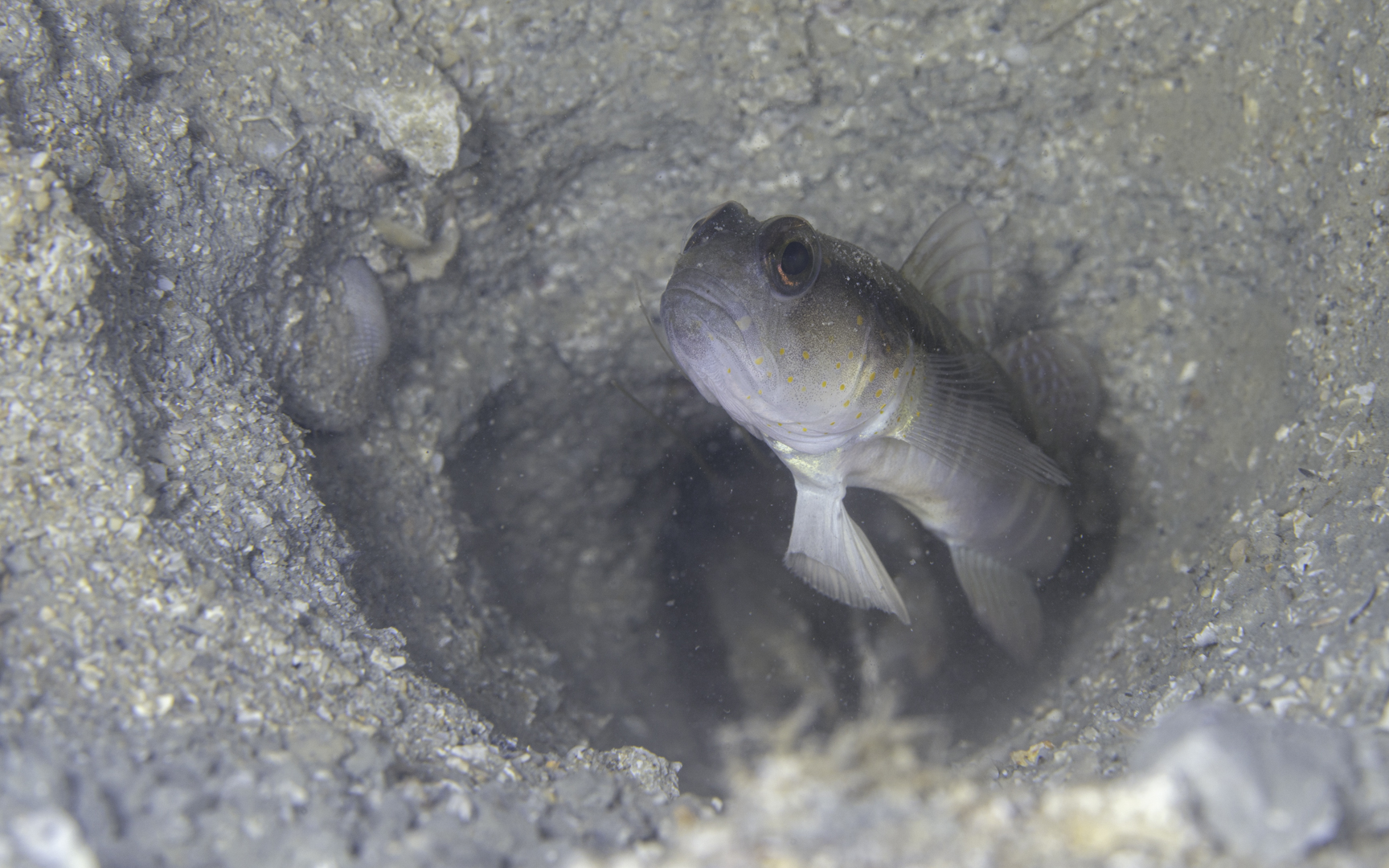
Myersina crocata – イエロースポッティッドシュリンプゴビー
Scientific Name: Myersina crocataEnglish Name: Yellow-Spotted shrimp-gobyObserved in: Pulau Hantu, SingaporeObserved Water Depth: Around 15-18mObserved Timing: Aug-22 当種は内湾の泥地のハゼとして一般的であるが、当地では漸くの初見となった。鰓蓋部の点はオレンジ色をしているが、日本で見るのは青色である。よって別種なのかもしれないと思ったが、オンラインの情報を漁った限りでは、この特徴が種を分けるものではなさそうなので、クロオビハゼとした。 (訂正)クロオビハゼだと思っていた当種であるが、Myersina crocataという別種であることが判明した。特徴は名前の通り鰓蓋部の黄色~橙色の点であり、比較的密に横帯が入っている。 体長は10cmを超えていそう。 Another Observation
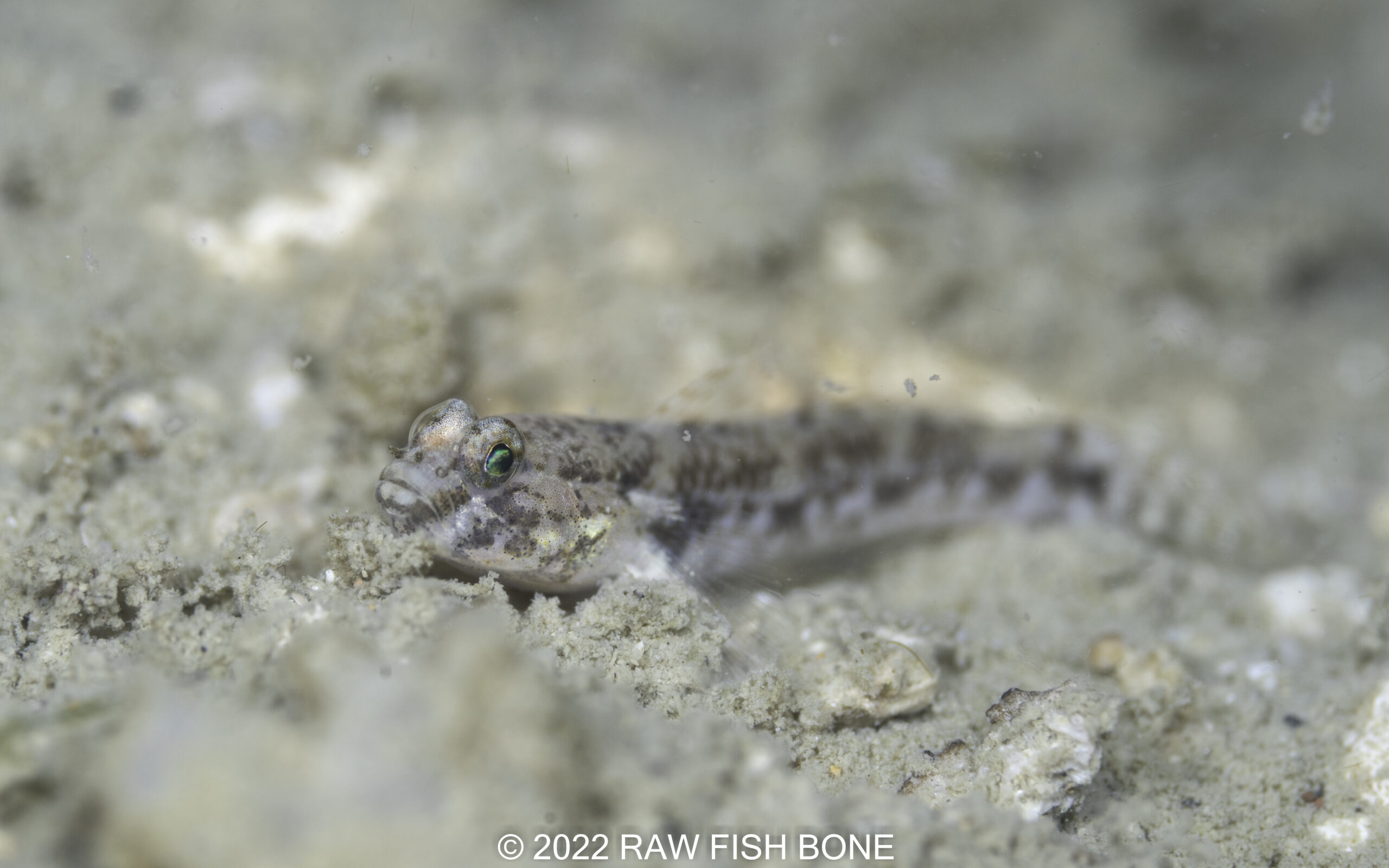
Acentrogobius sp. – キララハゼ属の1種
Scientific Name: Acentrogobius sp.English Name: –Observed in: Pulau Hantu, SingaporeObserved Water Depth: Around 15-18mObserved Timing: Nov-21, Aug-22 水深15mを超えると水中の浮遊物によって太陽光がほとんど遮られてしまい、ほどんどナイトダイブのようもなることがある。そうすると水中ライトなくば生物の探索は不能となるが、一方の彼らは昼間モードなのか、敏感にセンサーを働かせて巣穴にそそくさと隠れてしまう。そうしたジレンマと奮闘し続けること30分、いい加減心が折れかけていたその時に、砂に埋もれるようにじっとしていたのがこの個体。調べてみるとキララハゼ属の数種が当地に分布しているようである。本種もまた、外見的特徴からその一種と思うのだが、良い情報が見当たらず、後々訂正するかもしれない。もう1種の発見した当属(と思われる)ハゼは以下リンクです。
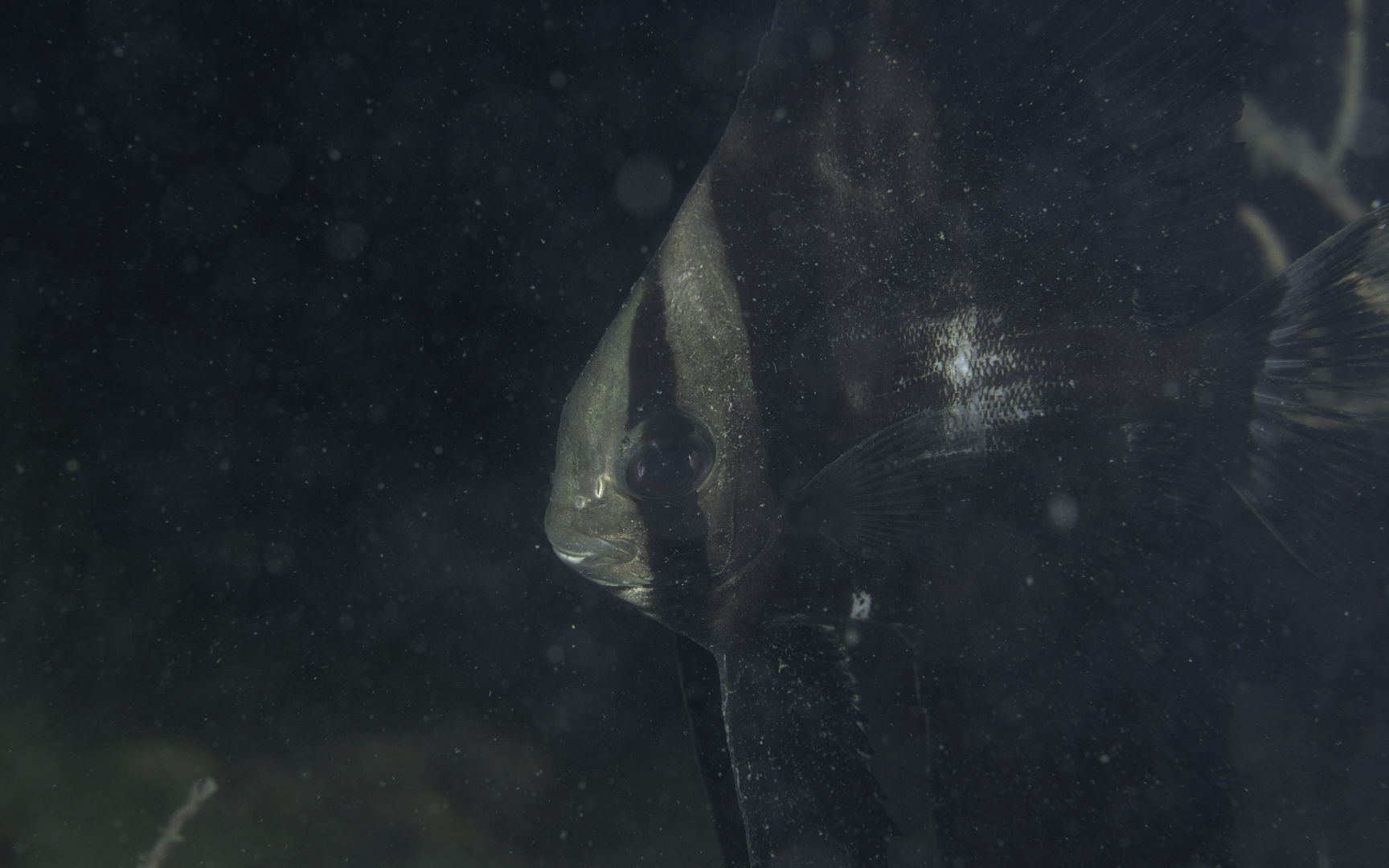
Platax batavianus – ゼブラバットフィッシュ
Scientific Name: Platax batavianus English Name: Humpback batfishObserved in: Pulau Hantu, SingaporeObserved Water Depth: Around 10mObserved Timing: Aug-22 ちょうど一時帰国からシンガポールに戻った5月、ふとFacebookを開けてみるとゼブラバットフィッシュの幼魚がHantuに出現したとの情報が投稿されていた。しかしどういうことだろうか、大事件として扱われてもよさそうなこの超レア生物の出現に対して、反応は薄く、投稿はひっそりと放置されていた。当地のダイバーの興味をひくものではなかったのだろうか。。その後、追加の目撃例も報告されなかったことから、まるで夢の話であったかのように、記憶の彼方に追いやられてしまった。 それから3か月程が経過したナイトダイブ。なんといたのですよ!育ってしまってゼブラじゃなくなってしまっていたけど!!ほかのツバメウオ属の幼魚と同じく、悠々と水底を泳ぐので、写真を撮るのはそこまで難しくはないのであるが、100㎜クラスのマクロレンズには大きすぎて、全身を収めることはできなかったのが悔やまれる。が、ほんとにシンガポールの海も捨ててもんじゃない!素晴らしい。当地の周りだと、レンベやバリ島でも観察されているようで、次回はぜひともゼブラ柄の幼魚を見てみたいなぁ。いい夜でした。
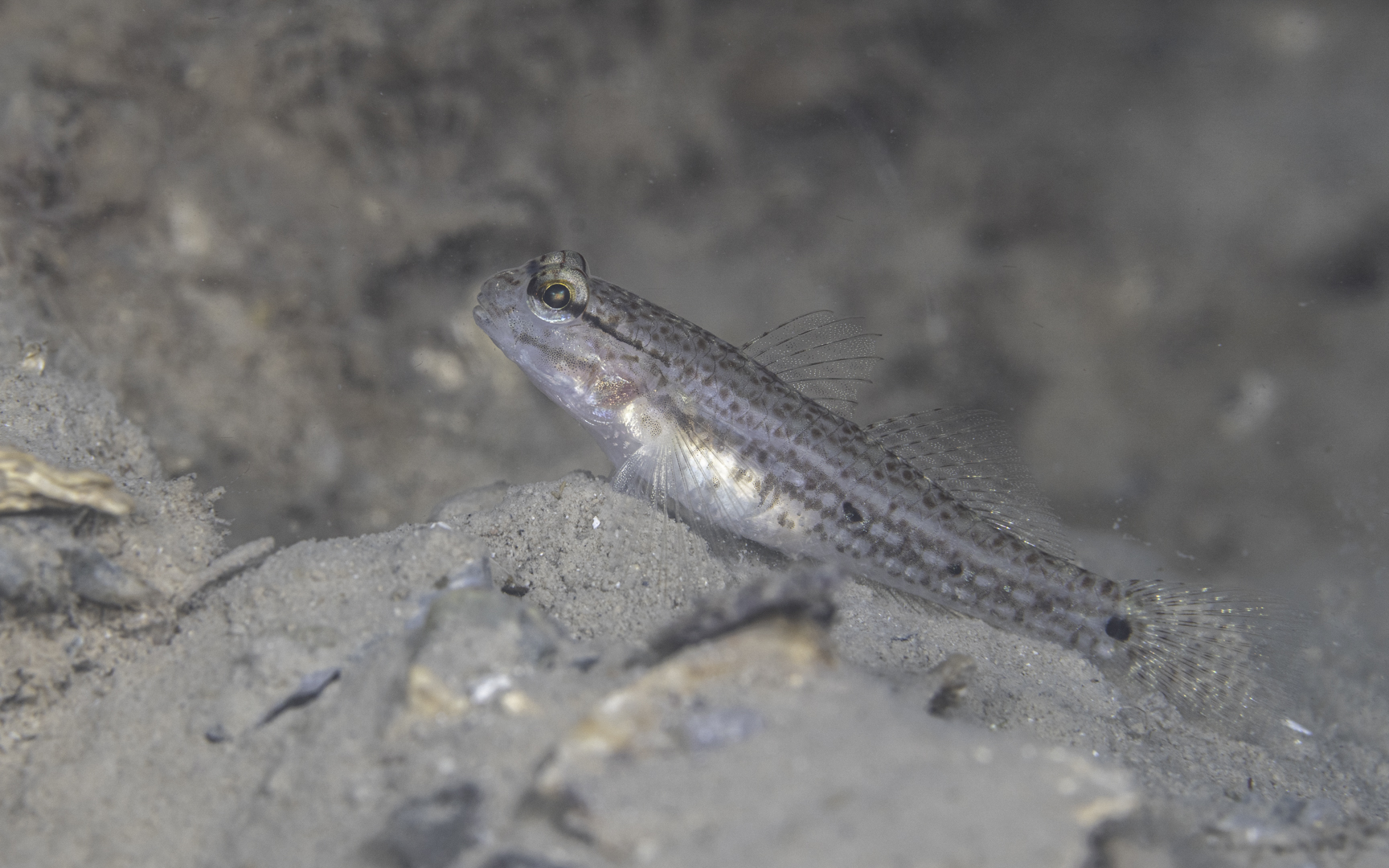
Istigobius goldmanni – ヒメカザリハゼ
Scientific Name: Amblyeleotris periophthalmaEnglish Name: Black-spotted lagoon-gobyObserved in: Pulau Hantu, SentosaObserved Water Depth: 3-15mObserved Timing: Anytime クツワハゼ属の分類ちょっとよくわからないので、とりあえず。あとで見直す。
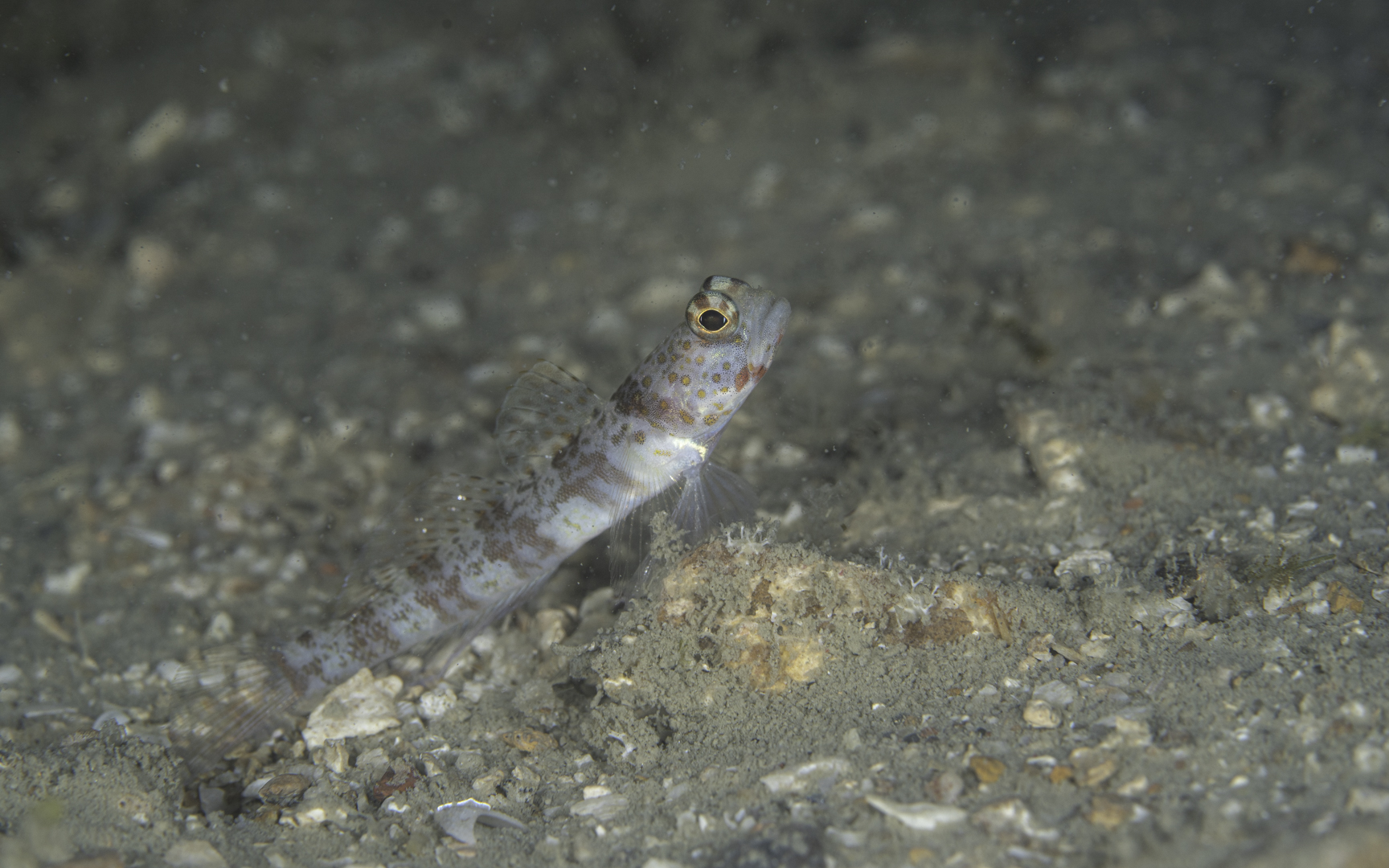
Amblyeleotris periophthalma – ダンダラダテハゼ
Scientific Name: Amblyeleotris periophthalmaEnglish Name: Periophthalma prawn-gobyObserved in: Pulau HantuObserved Water Depth: Around 15mObserved Timing: Jul-22, Aug-22 久しぶりに潜ったシンガポールの海。透明度はいつものように悪いが、いつにもまして目が慣れてこない。マスクが曇っているのか、単に視界が悪いのかわからんが、何度もマスククリアをしていると、さらに視界は曇る。一面魚だらけの八重山の記憶が、一瞬にして塗り替えられた。難しい海だ。 そうしてしばらくモヤモヤしていると、突然前方にポツンと背筋を伸ばしたハゼがいるではないか。この美しい体色と模様はダンダラダテハゼ。八重山では決して珍しい種ではないが、当地では初めて見た。若魚の段階、水深は少し深めの15メートル。暫く泳いでいると、成魚にも出会えた。棘条となった第一背鰭がカッコいい。その後の目ぼしい出会いはなかったが、この子で十分満足の一本。
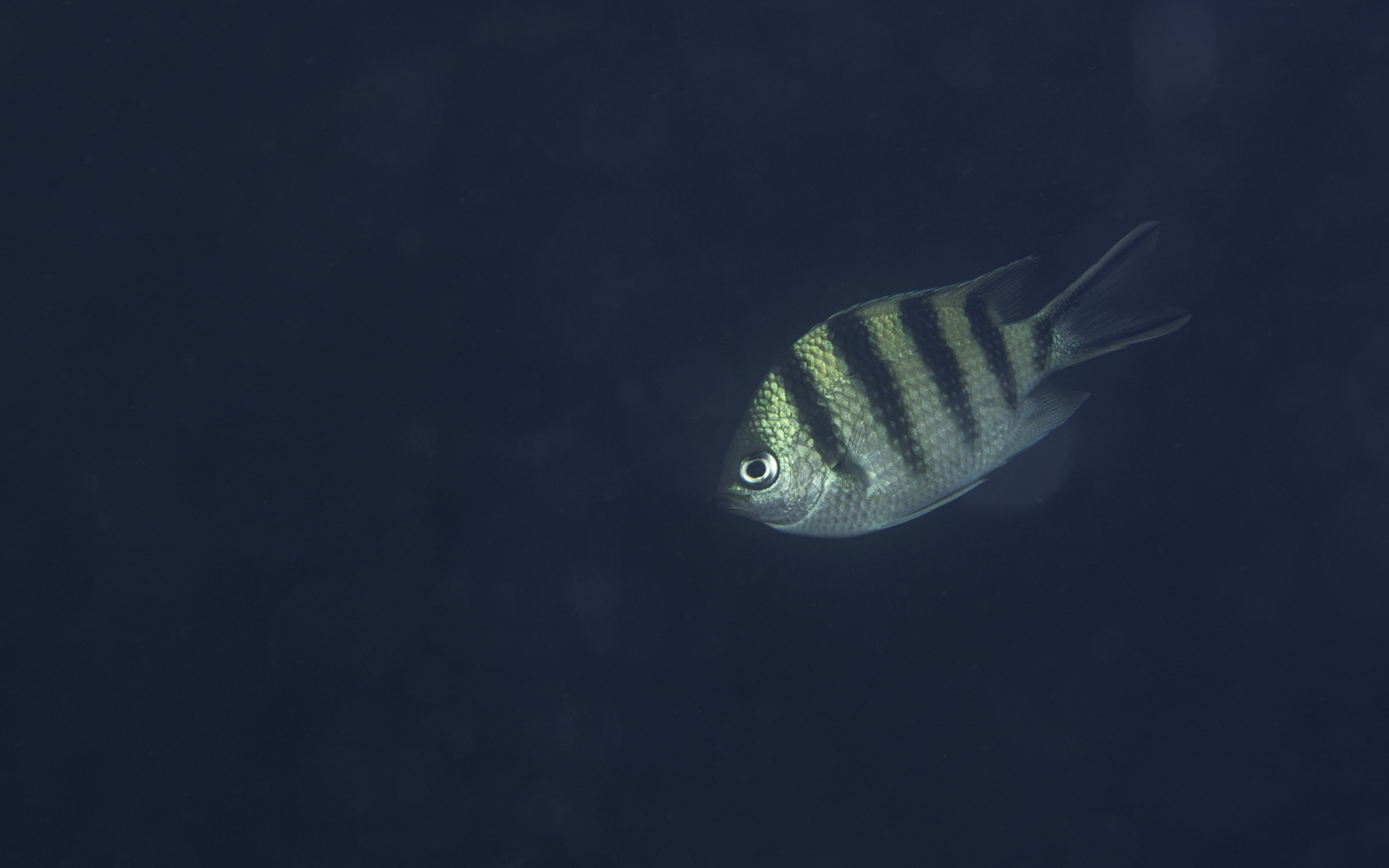
Abudefduf sexfasciatus – ロクセンスズメダイ
Scientific Name: Abudefduf sexfasciatusEnglish Name: Scissortail sergeantObserved in: Sentosa SingaporeObserved Water Depth: Less than 5mObserved Timing: Jun-22
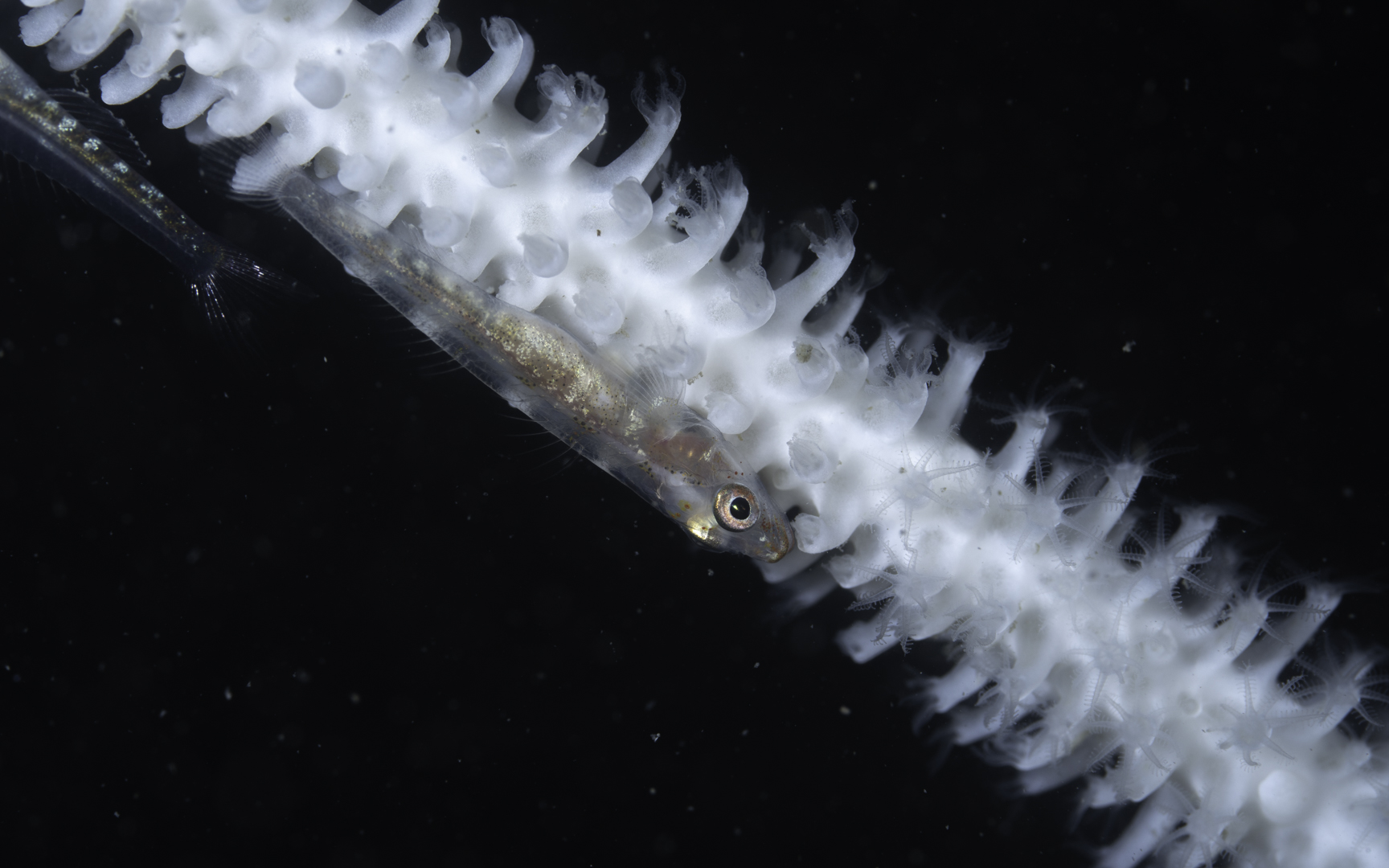
Bryaninops sp. – ガラスハゼ属の1種
Scientific Name: Bryaninops sp.English Name: –Observed in: Pulau Hantu, SingaporeObserved Water Depth: Around 20mObserved Timing: Feb-22 水深20mにて観察。体色からしてウミショウブハゼ属なのかなとも思ったが。そういえば、両属を区別するものってなんなんでしょう。このウミヤギに複数個体がついてました。同定に至るような情報もなく、またの機会が得られるまではとりあえず。
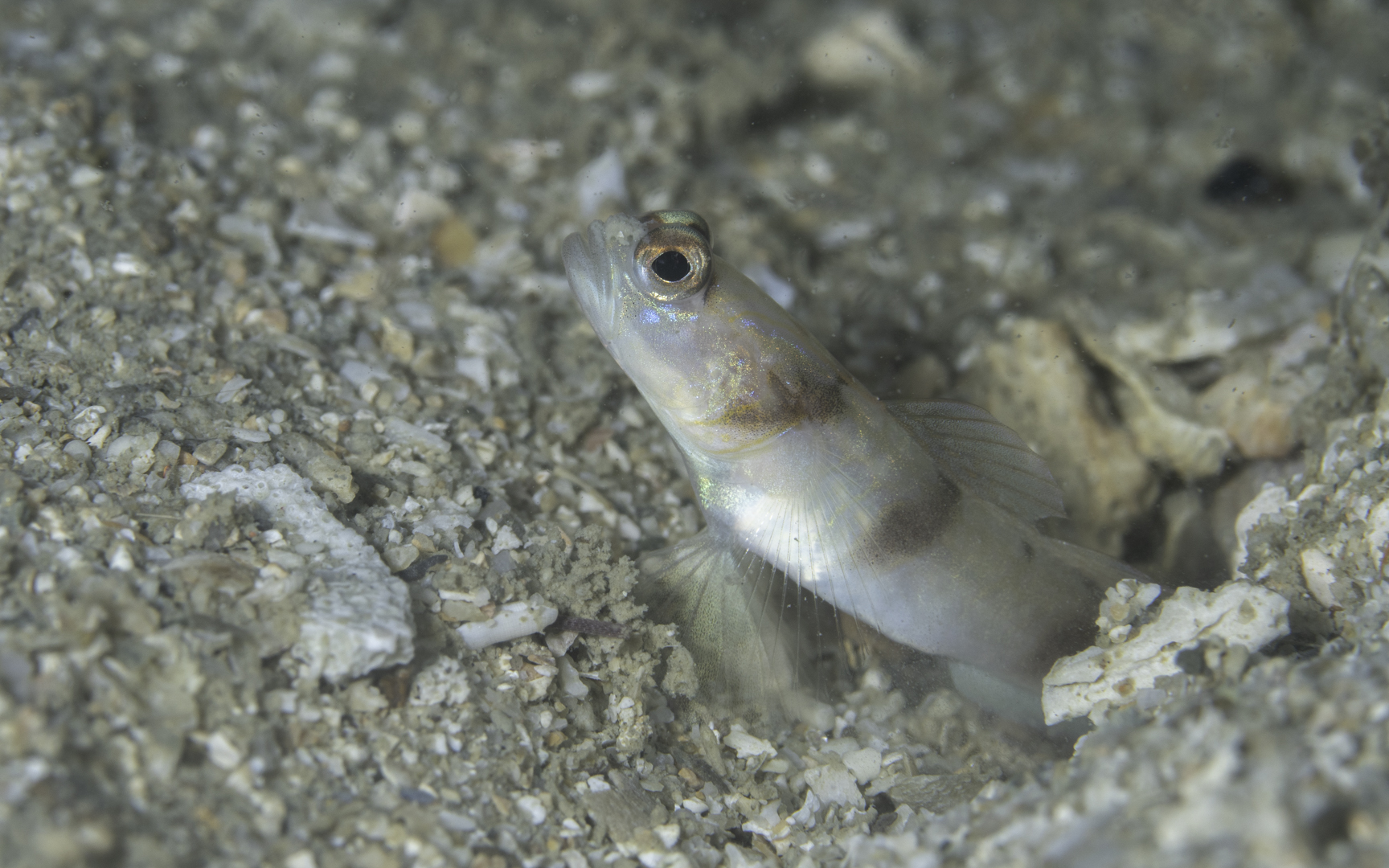
Amblyeleotris sp. – ダテハゼの1種
Scientific Name: Amblyeleotris sp.English Name: –Observed in: Pulau Hantu, SingaporeObserved Water Depth: Around 15mObserved Timing: MAR-22 透明度が3m未満であることが通常である当地の海において、水深20m程度ともなると太陽光が遮られほとんどナイトダイブに近い様相となることもある。幸いにも撮影時には比較的水が澄んでおり、過度にライトを当てることなく生物探索をすることができた。当個体は幼魚であり、第一背鰭に黄小点が密在しているなどヒメダテハゼに似るが、横帯の入り方が異なっており取り合えずspとしておく。 Side Story photography ヒメダテハゼ雄のディスプレイ行動。鰭を全開にして飛び立つ。共生エビに部屋掃除をさせつつ、自身は玄関口でだらっとしている、あのいつもの感じとは、打って変わった逞しさにあふれている。
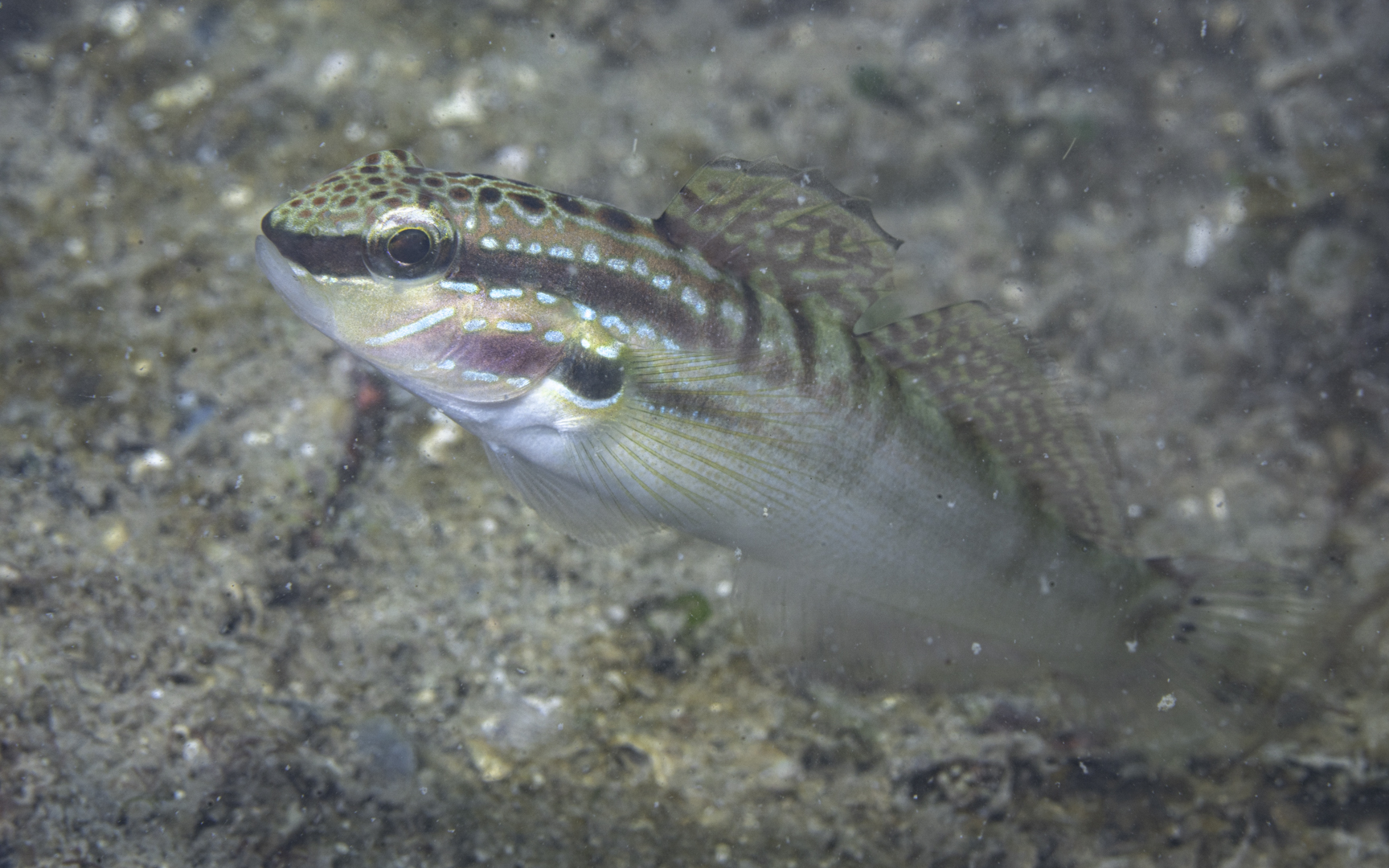
Amblygobius stethophthalmus
Scientific Name: Amblygobius stethophthalmusEnglish Name: Head-stripe lagoon-gobyObserved in: Pulau Hantu & Sentosa, SingaporeObserved Water Depth: Around 5-15mObserved Timing: Anytime 当地では一般的なサラサハゼ。絶妙な(というか微妙な?)色の取り合わせは、、ちょっと悪趣味な感じがしないでもない。ペアでいたり単独でいたり、水路脇でずっと鰭を開いてフワフワしてたりもする。疲れないのかしら。英名はFreckled gobyともいうらしい、つまりソバカスハゼ。額のところの斑点のことですね。 https://www.fishbase.se/summary/62722
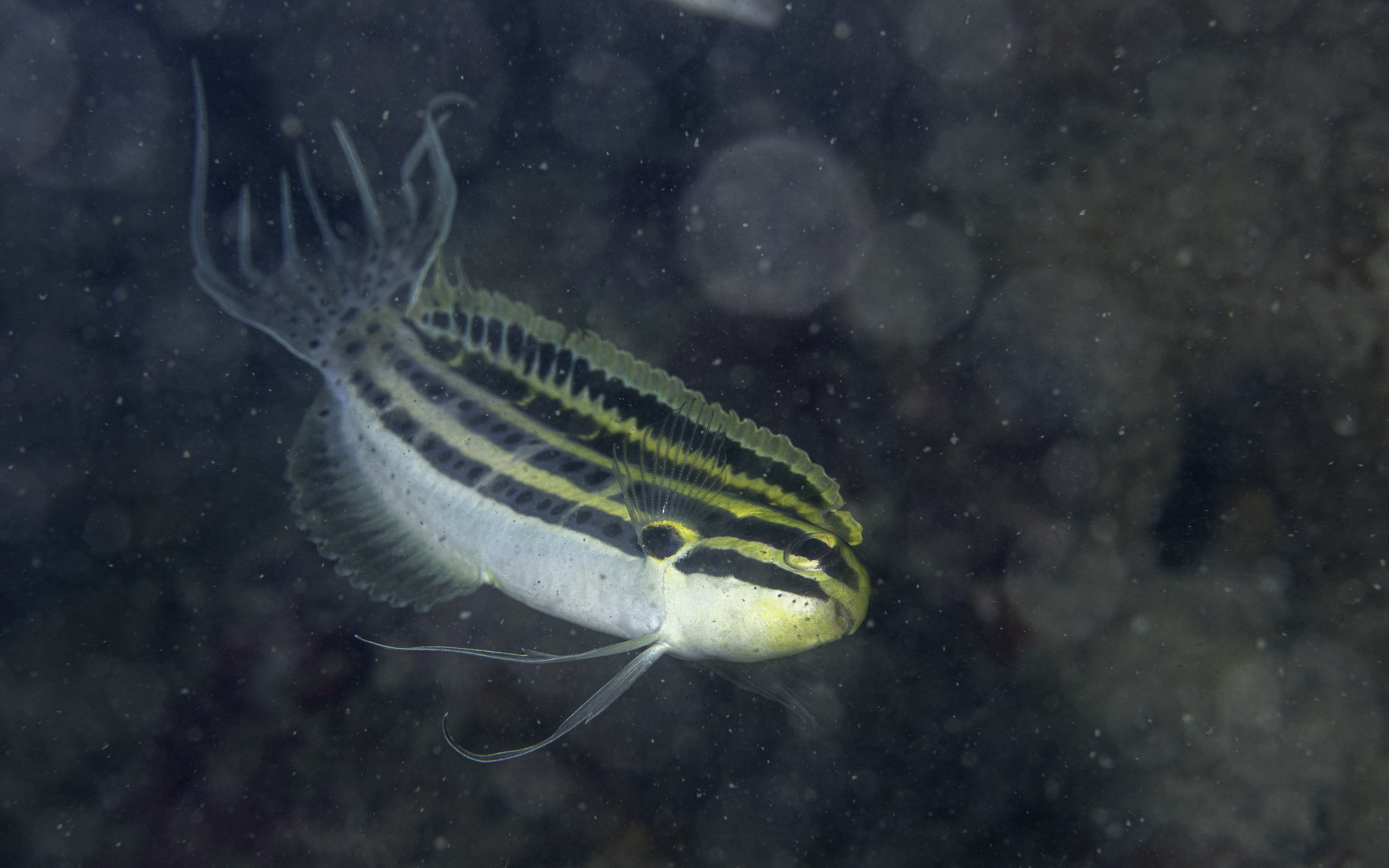
Meiacanthus grammistes – ヒゲニジギンポ
Scientific Name: Meiacanthus grammistesEnglish Name: Striped blennyObserved in: Pulau Hantu, SingaporeObserved Water Depth: Around 10-15mObserved Timing: Jan-22 複数匹でくるくる回って威嚇し合っていたヒゲニジギンポ。いつかの沖縄で見たオウゴンニジギンポもこうした行動をとっていた。 一見、求愛なのかと勘違いしてしまうほど優雅な行動である。泳ぎすぎていかず、ヒレを開いてディスプレイをするので撮影には持ってこいのシーンだ。こうして比較してみると、ヒゲニジギンポは鰭が長く大きく迫力がある。 なお今回分類を整理するにあたり、ギンポが複数科に分かれて存在していることを初めてしった(ギンポ科に複数属がぶら下がっているのだと思っていた。。)。そこまでギンポの写真が増えるとも思えず、分類の粒度が合わなくてとても気持ち悪いのであるが、ギンポ亜目としてまとめることとした。なお本種はイソギンポ科に属す。毒を持っている。 Side Story Photography くるくる回るオウゴンニジギンポ(Meiacanthus atrodorsalis)。こいつも有毒。
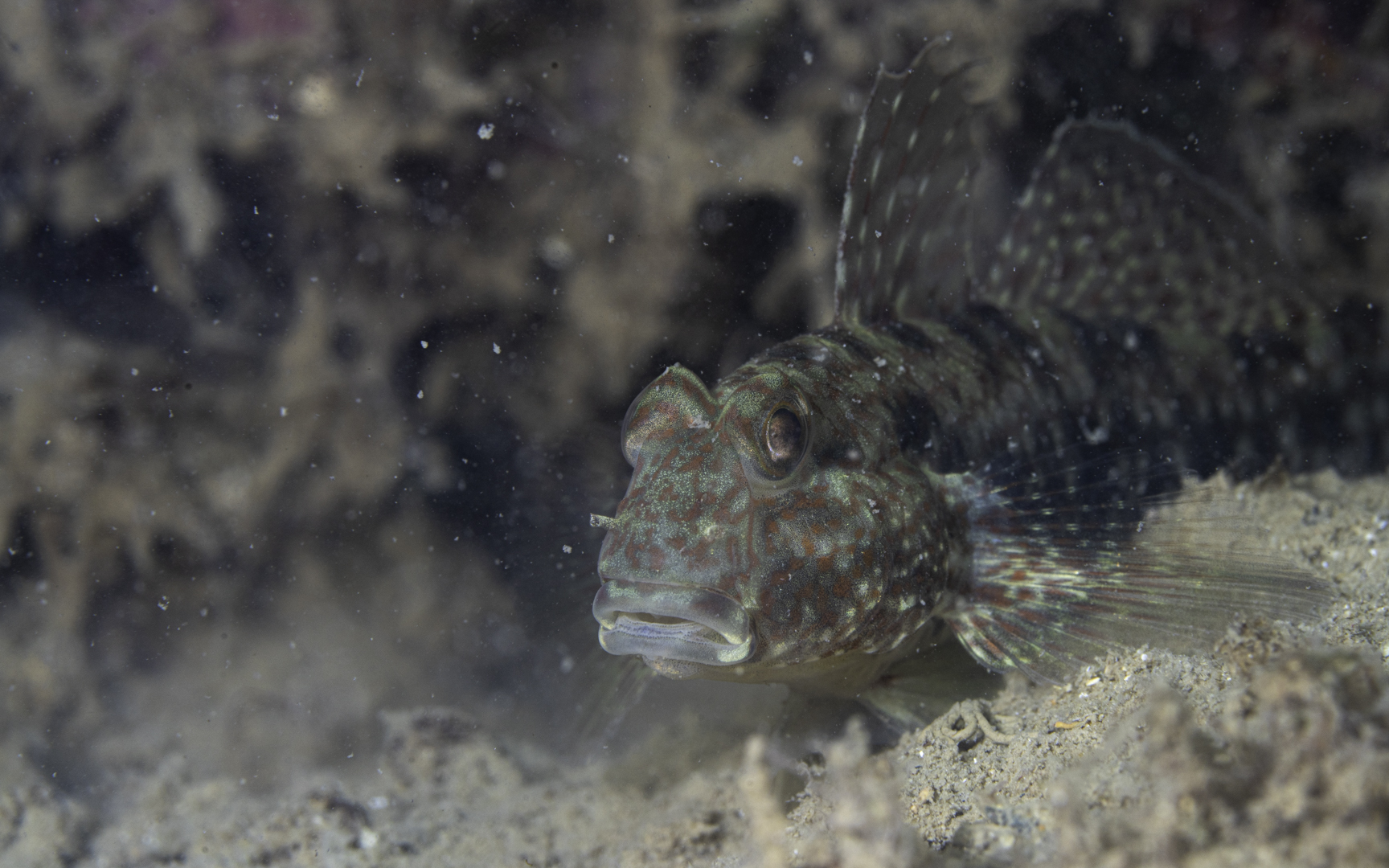
Exyrias belissimus – オバケインコハゼ
Scientific Name: Exyrias belissimusEnglish Name: Mud reef-gobyObserved in: Pulau Hantu & Sentosa, SingaporeObserved Water Depth: Around 3-15mObserved Timing: Anytime オバケインコハゼと言ったら撮れそうで撮れないハゼであった。ファインダーを向けようとするとヌルっとサンゴの奥や岩陰に逃げ込まれ、悔しい思いを何度もしてきたのは私だけではあるまい。どんくさそうな見てくれに騙されてはいけないのだ。細心の注意を以てアプローチし、最小限の動きでそっとシャッターを切らねばならない。 しかし(!)、当地では撮り放題である。数が多く、サンゴやガレなどから離れたオープンスペースでぼーっとしているのをよく見かける。体調は大きいもので10cmを超える。幼魚は見ないが、若魚はそれなりに数がいる(写真3,4枚目がそれ。当初はマダラハゼか何かかと思ったが顔の特徴や胸鰭上部の様子はオバケインコハゼだ)。
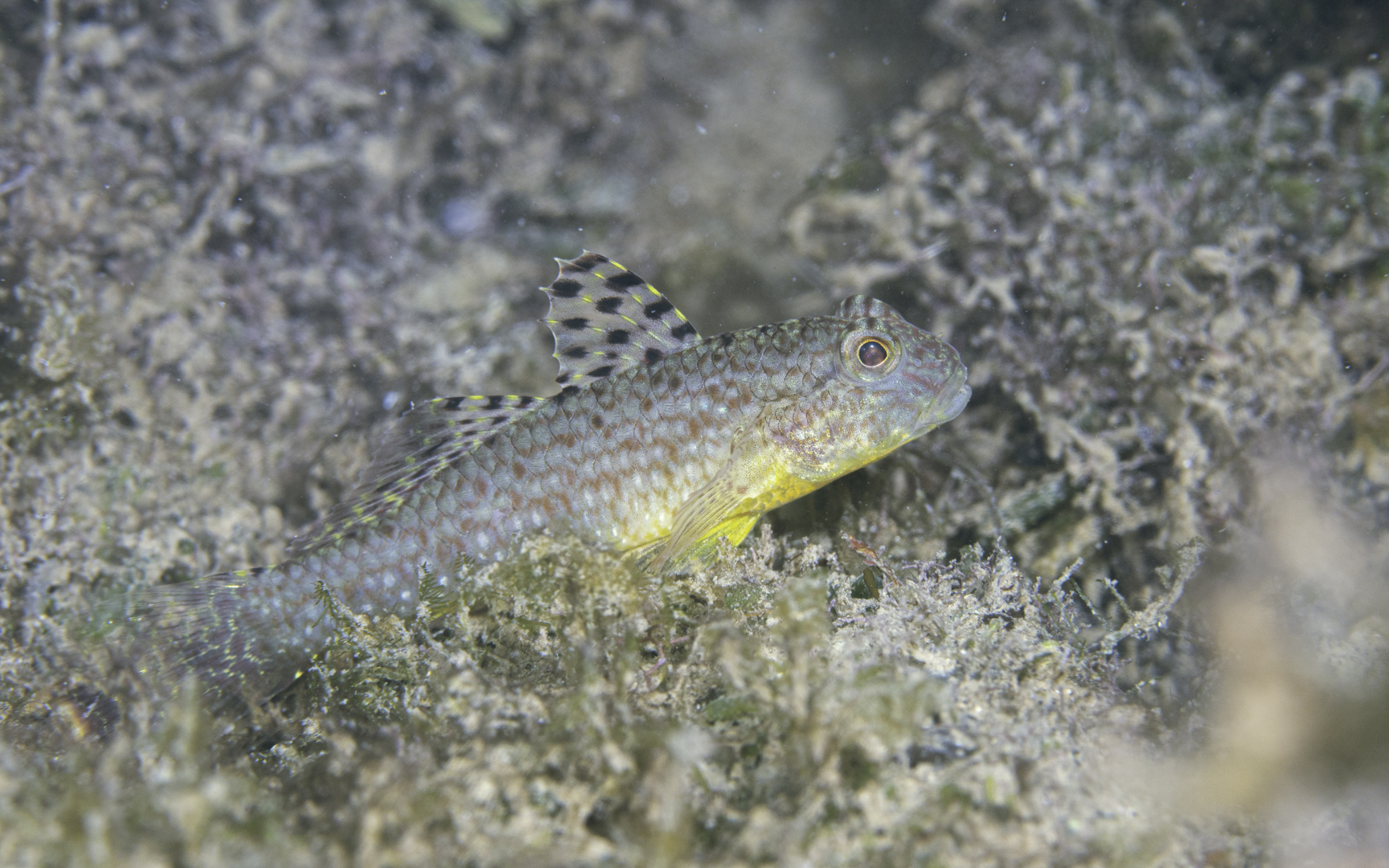
Exyrias puntang – インコハゼ
Scientific Name: Exyrias puntangEnglish Name: Puntang gobyObserved in: Sentosa, SingaporeObserved Water Depth: Less than 3mObserved Timing: Anytime ヒルギ(マンングローブ)の根本にいる汽水域のハゼとして認識していましたが、当地では港の中の水深数メートルの開けた転石の周りにおり、姿を確認すること自体は容易ですが、写真を撮ろうと気取られた瞬間、ヌルっと岩陰に逃げていきます。 岸壁の縁に吹き溜まりとなっている泥まみれの海藻を、口の中に入れているのもよく観察されます。味覚があって食事をしているわけではないのかもしれないが(実際どうなんだろう)、この子には生まれ変わりたくはないなぁ。 成長した個体もまま見られ、その全長は100mmクラスのマクロレンズでは収めるのが困難なほどに大きくなります。背鰭は常時開きっぱなしでいます。インコハゼ属の特徴なのでしょうか。 Side Story photography 同属のイトヒキインコハゼ – Exyrias Akihito、豪華な鰭を全開にしながら泥がかった水底を移動している。学名はハゼ学者の上皇陛下への献名。高貴ですね。
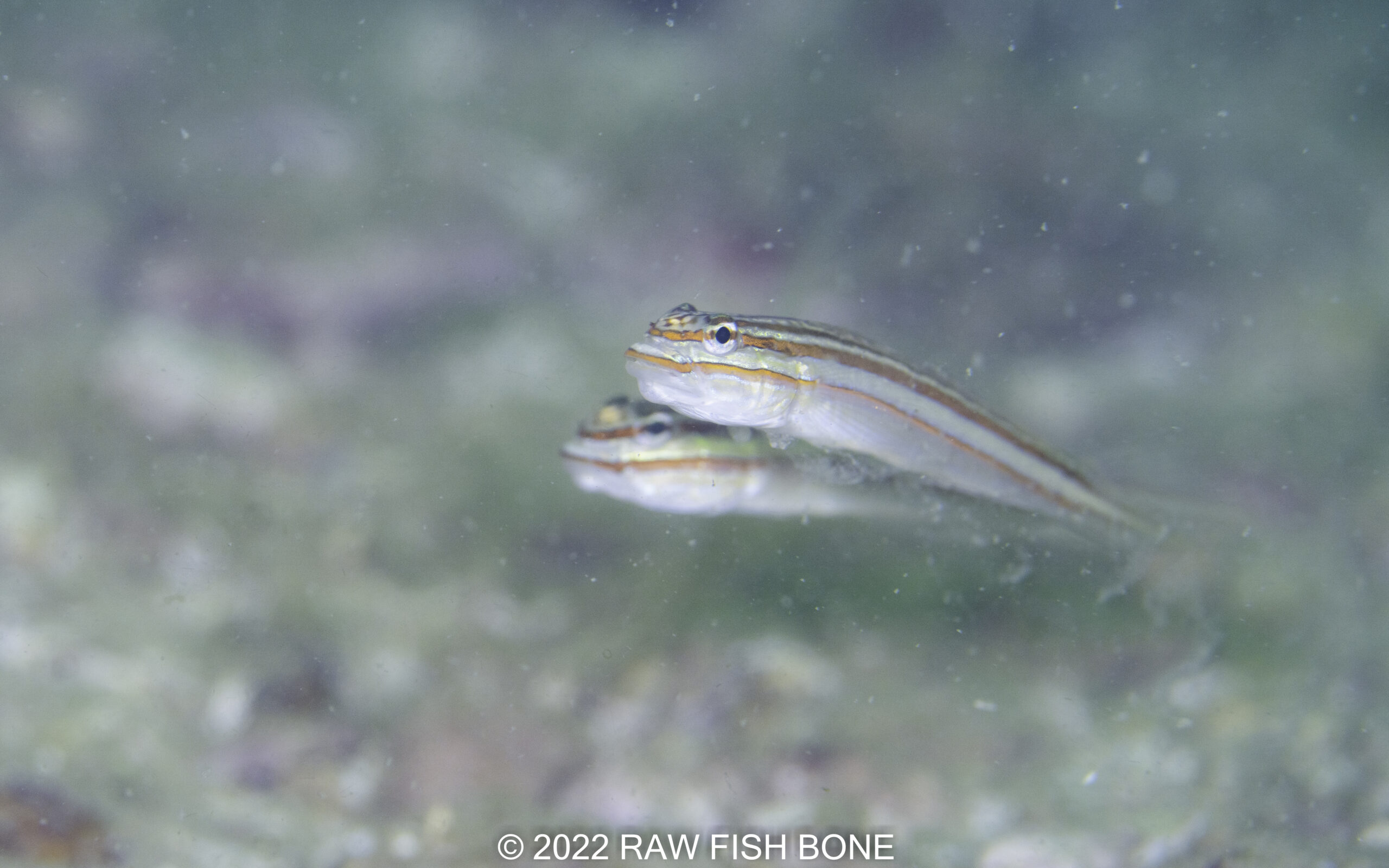
Valenciennea immaculata – イマキュレートゴビー
Scientific Name: Valenciennea immaculataEnglish Name: Immaculate GlidergobyObserved in: Pulau Hantu, SingaporeObserved Water Depth: Around 10-15mObserved Timing: Nov-21 If you want to see a variety of goby, Hantu West is the best choice. Paying full attention not to create smoking and keeping a needful distance to them, you may get reasonable number of opportunity for observation. 日本にはいないクロイトハゼ属、イマキュレートゴビー。観察した個体はまだ小さく、綺麗な色をしている。当地で潜り始めてまもなく観察機会を得たが、それ以降は一度も出会っていない。生息環境の当たりはついているので、ちゃんと探せばまたいるかな。 ttps://fishesofaustralia.net.au/home/species/174
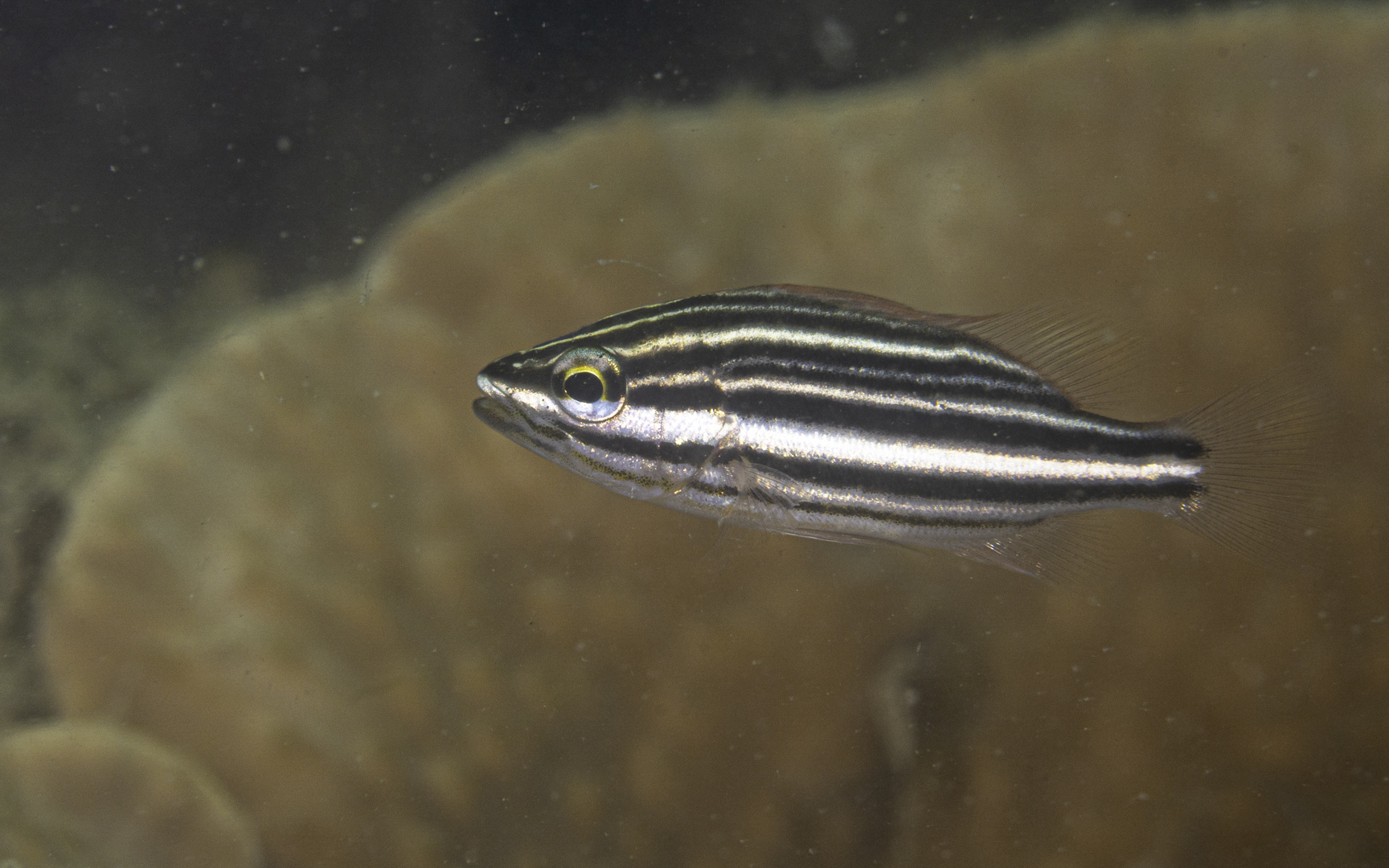
Nemipteridae sp. – イトヨリダイ科の1種
Scientific Name: Nemipteridae sp.English Name: Monocle Bream sp.Observed in: Sentosa, SingaporeObserved Water Depth: Less than 5mObserved Timing: Anytime A common monocle bream often find in shallow water. It has pinkish fins.It must have a specific name but still cannot find a good information. 当地では数少ないイソハゼをサンゴ周りで探していたところ、視界のわきからヌルっと現れた。そんな動きがテンジクダイ的で、思わずファインダーを奪われてしまった。鰭がややピンクがかっている。 図鑑他の情報に当たってみたが、同定に至るものは見つけることができず、とりあえずspとしておく。このエリアでは最も安定的に観察できるタマガシラの1種であり、きっと学名も英名もついていると思うので、諦めずに同定のための情報を探してみようと思う。
